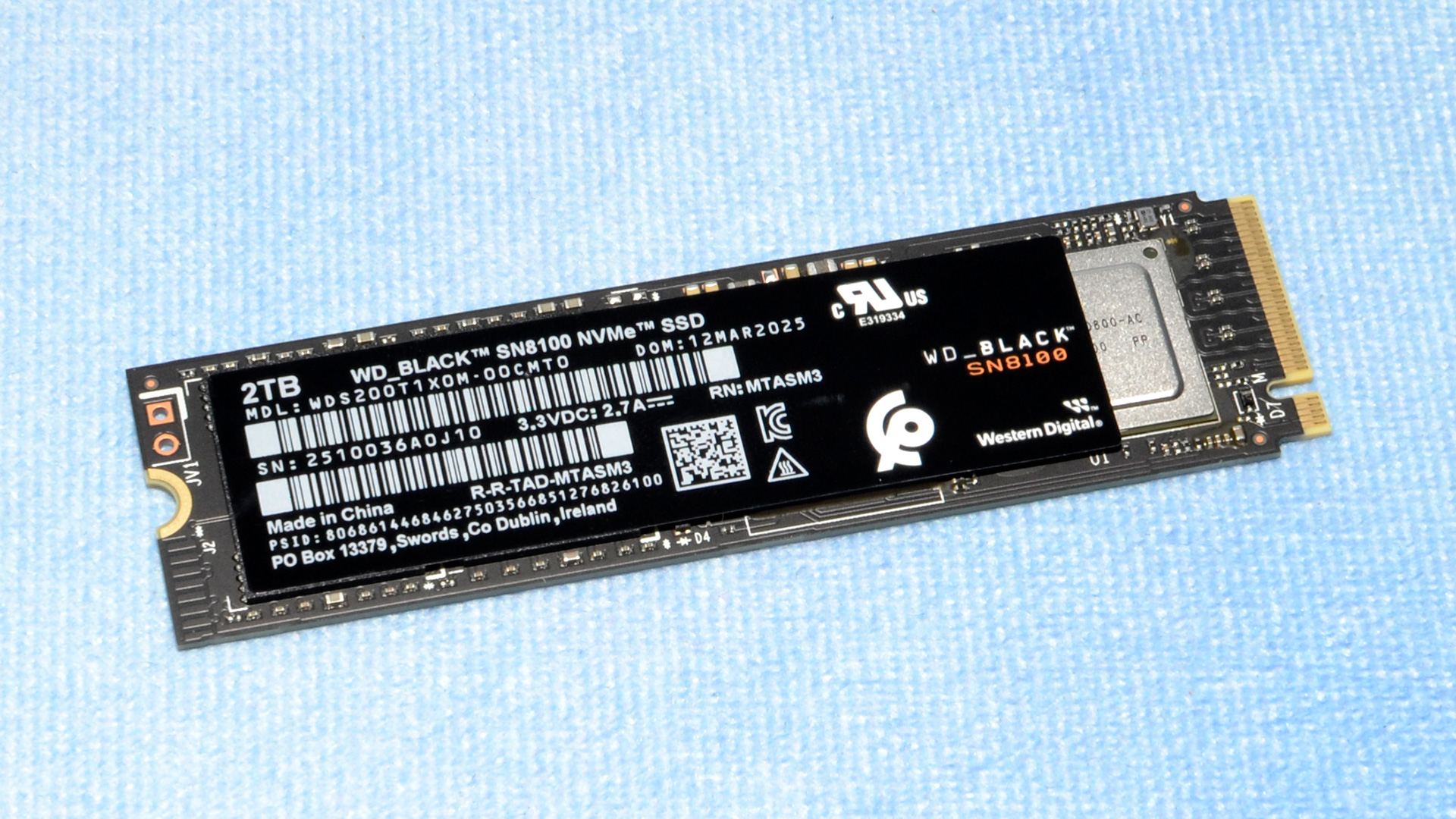Why you can trust Tom's Hardware
Trace Testing — 3DMark Storage Benchmark
Built for gamers, 3DMark’s Storage Benchmark focuses on real-world gaming performance. Each round in this benchmark stresses storage based on gaming activities including loading games, saving progress, installing game files, and recording gameplay video streams. Future gaming benchmarks will be DirectStorage-inclusive and we also include notes about which drives may be future-proofed.

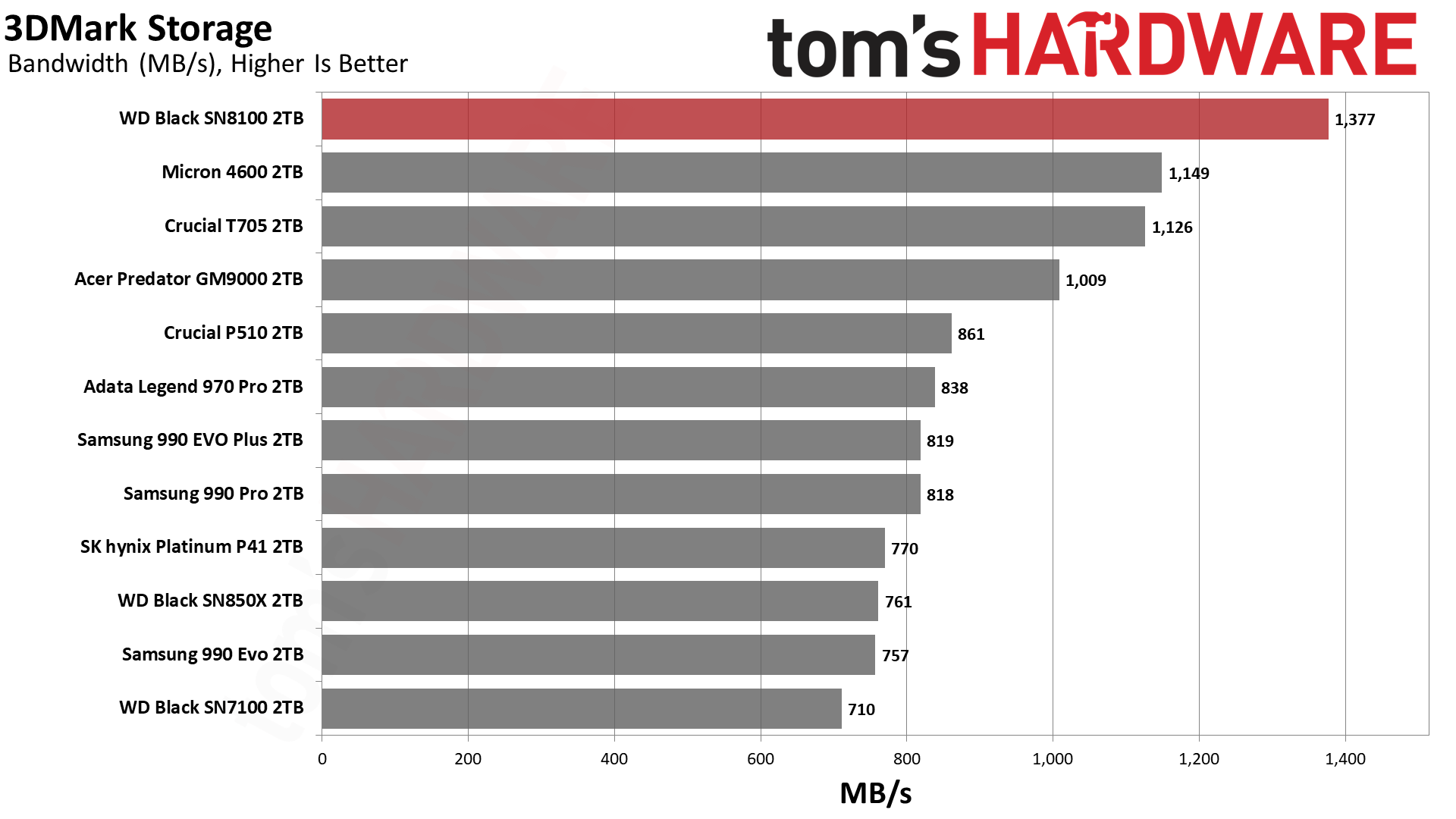
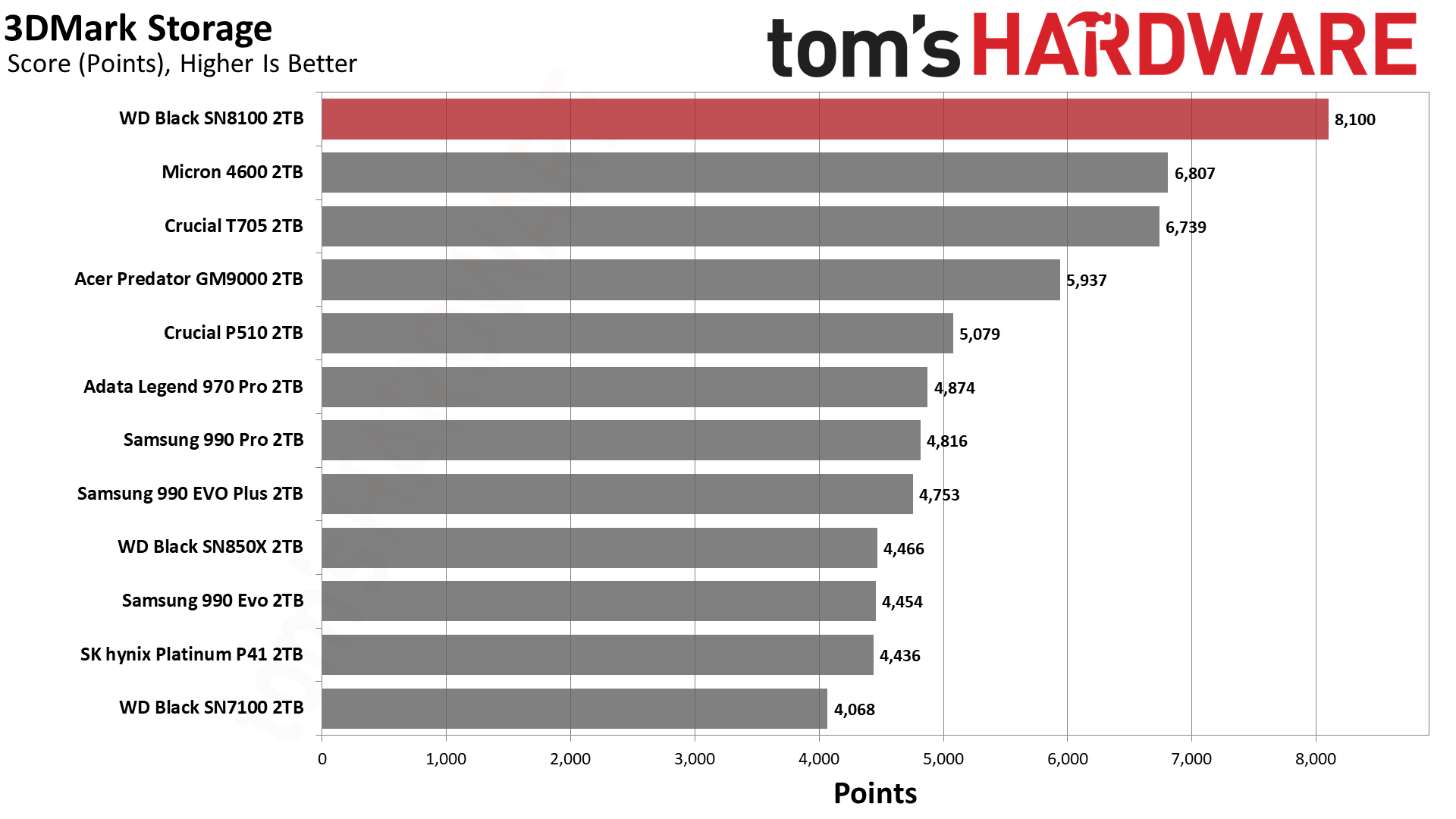
The WD Black SN8100 has a ton of bandwidth available to it, with some advantages over its nearest competitors, the T705 and the 4600. The T705 relies on older technology and can’t fully utilize the PCIe 5.0 interface. As for the 4600, it uses the same controller as the WD Black SN8100 but is using different flash – Micron’s own 272-Layer TLC flash, instead – and is an OEM drive with different requirements than the retail WD Black SN8100. This gives the advantage to the latter, which turns in the fastest results we’ve ever seen.
Trace Testing — PCMark 10 Storage Benchmark
PCMark 10 is a trace-based benchmark that uses a wide-ranging set of real-world traces from popular applications and everyday tasks to measure the performance of storage devices. The results are particularly useful when analyzing drives for their use as primary/boot storage devices and in work environments.
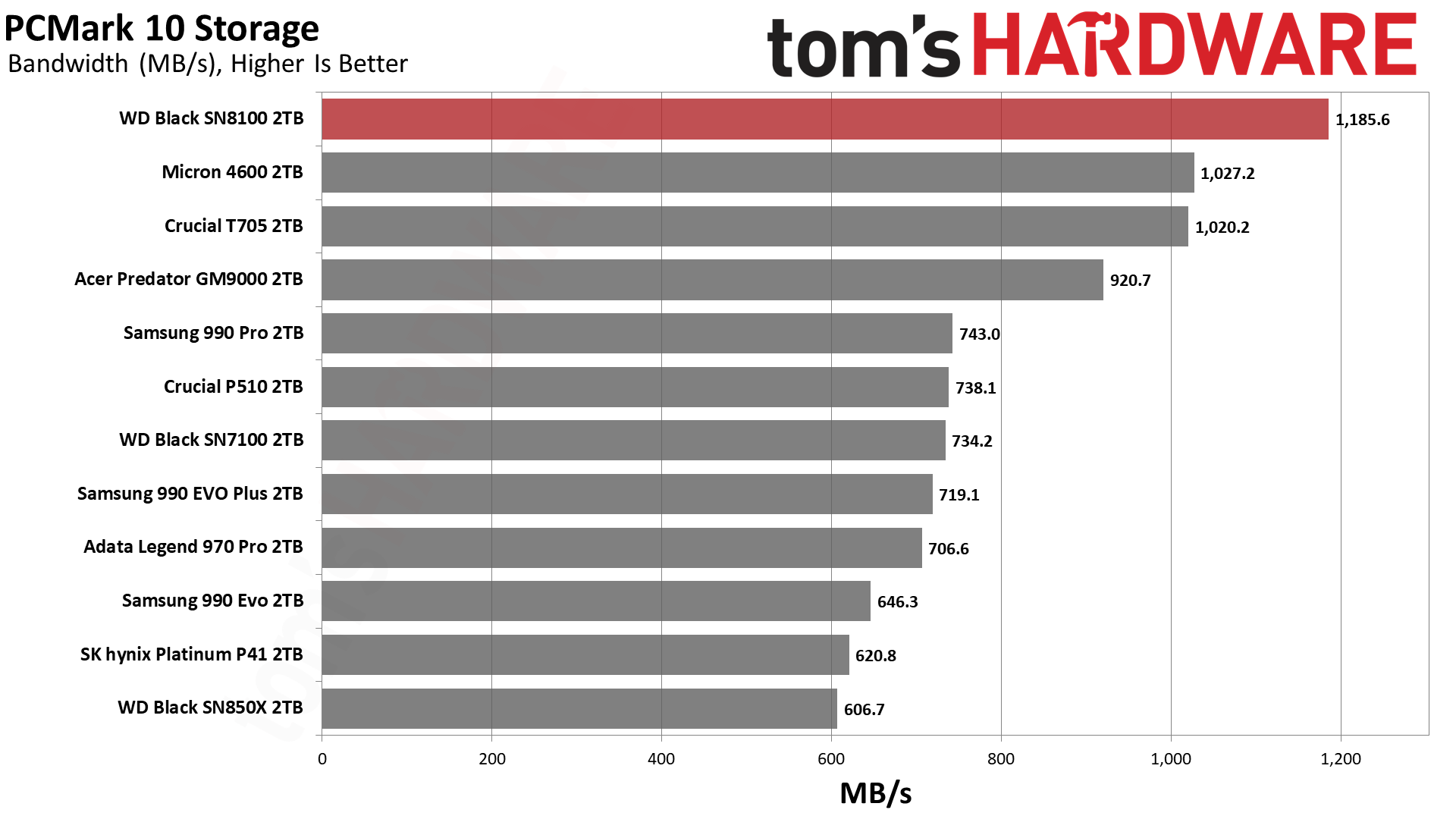
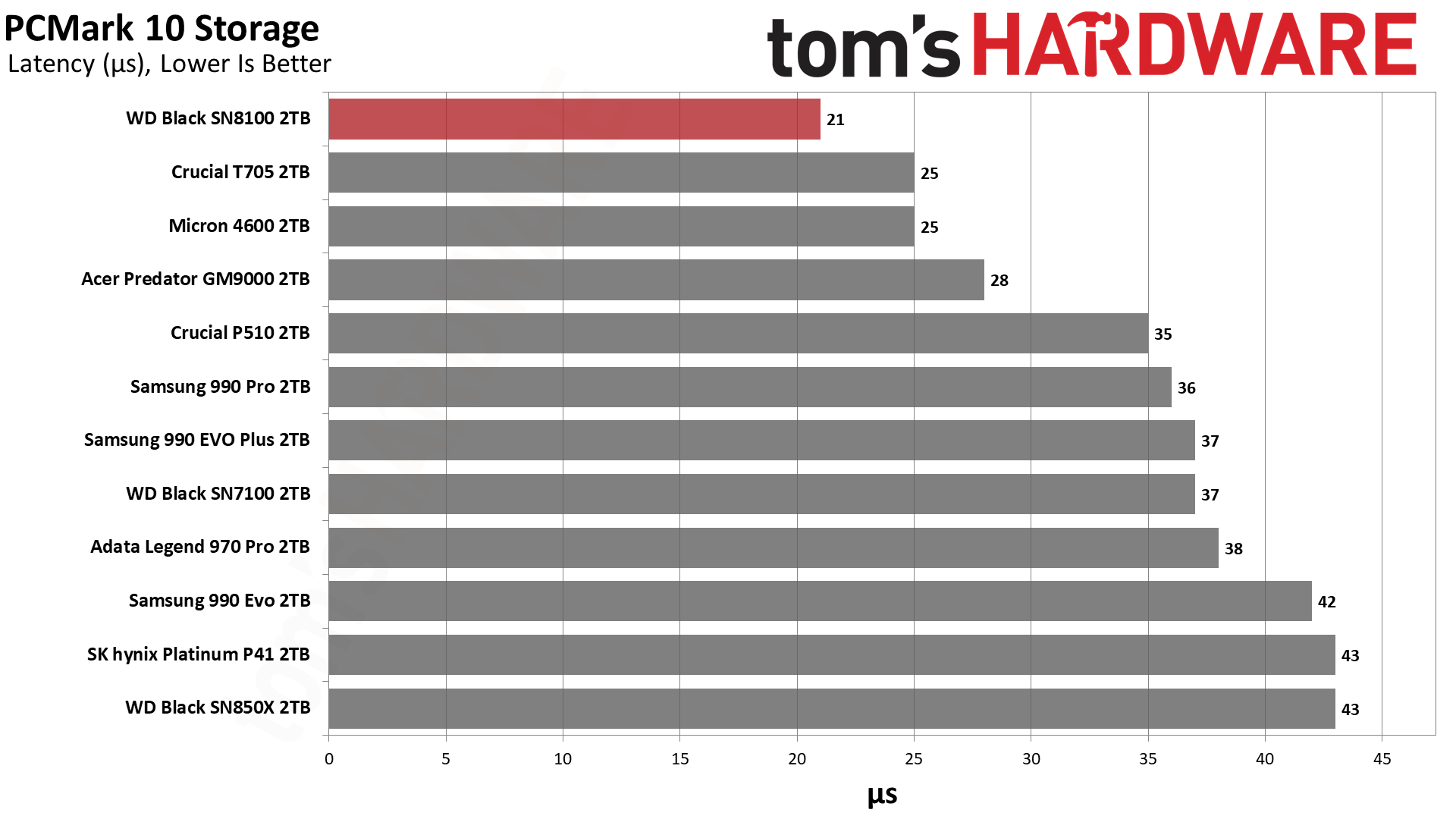
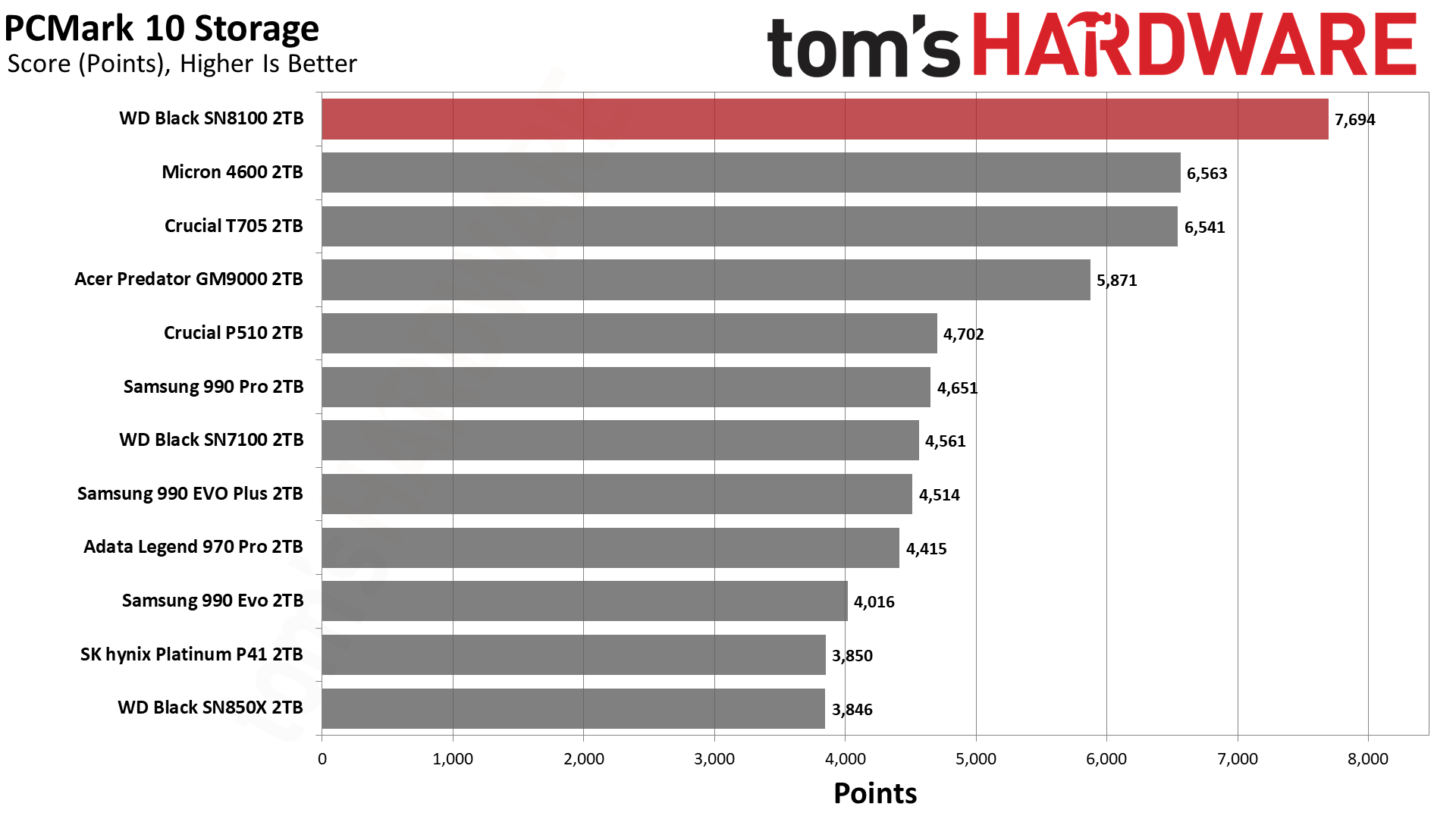
The WD Black SN8100’s domination over the competition does not abate in PCMark 10. It scores record numbers with a clear lead over existing high-end PCIe 5.0 SSDs. This is top-tier application performance.
Transfer Rates — DiskBench
We use the DiskBench storage benchmarking tool to test file transfer performance with a custom, 50GB dataset. We write 31,227 files of various types, such as pictures, PDFs, and videos to the test drive, then make a copy of that data to a new folder, and follow up with a reading test of a newly-written 6.5GB zip file. This is a real world type workload that fits into the cache of most drives.
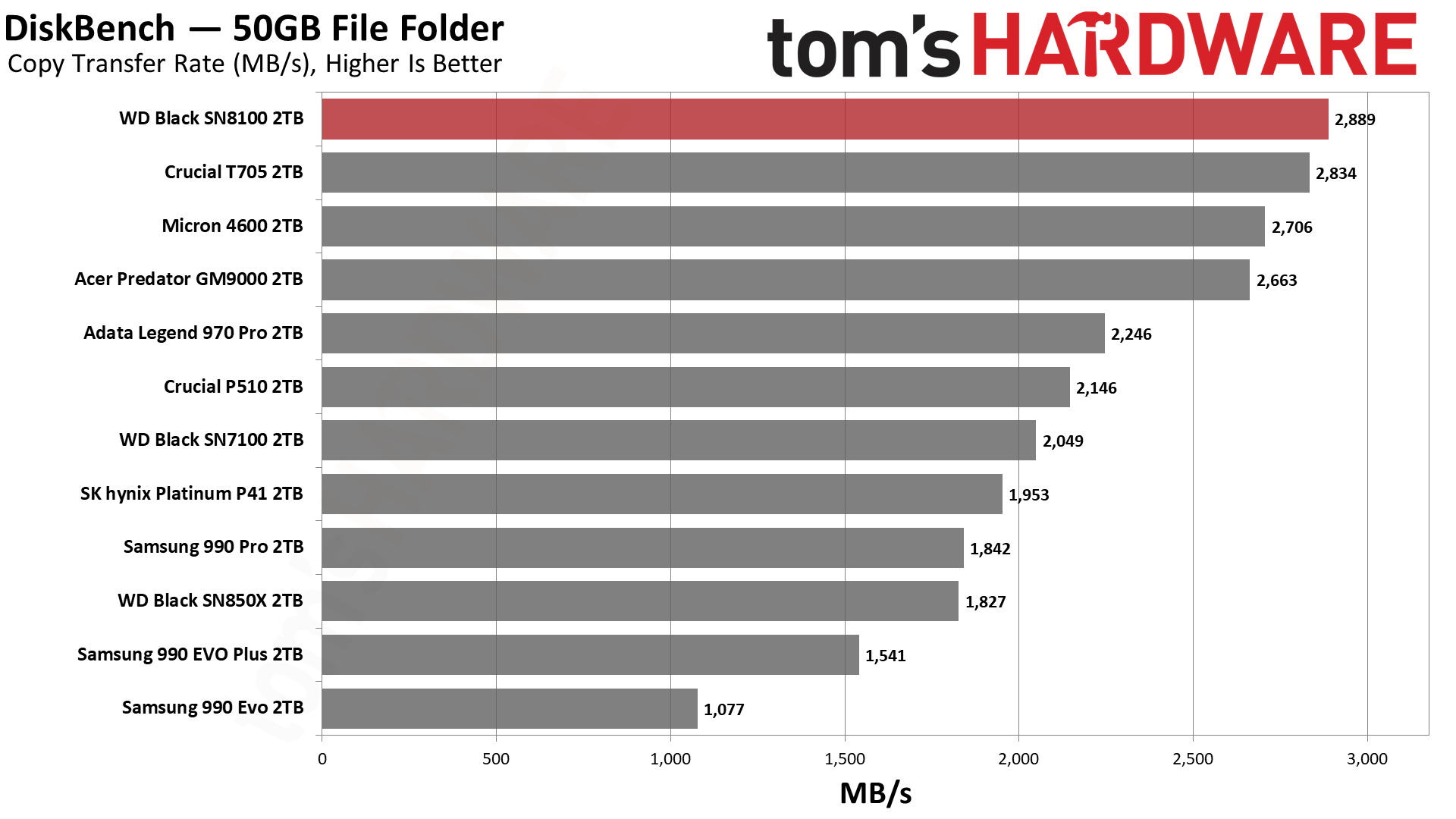
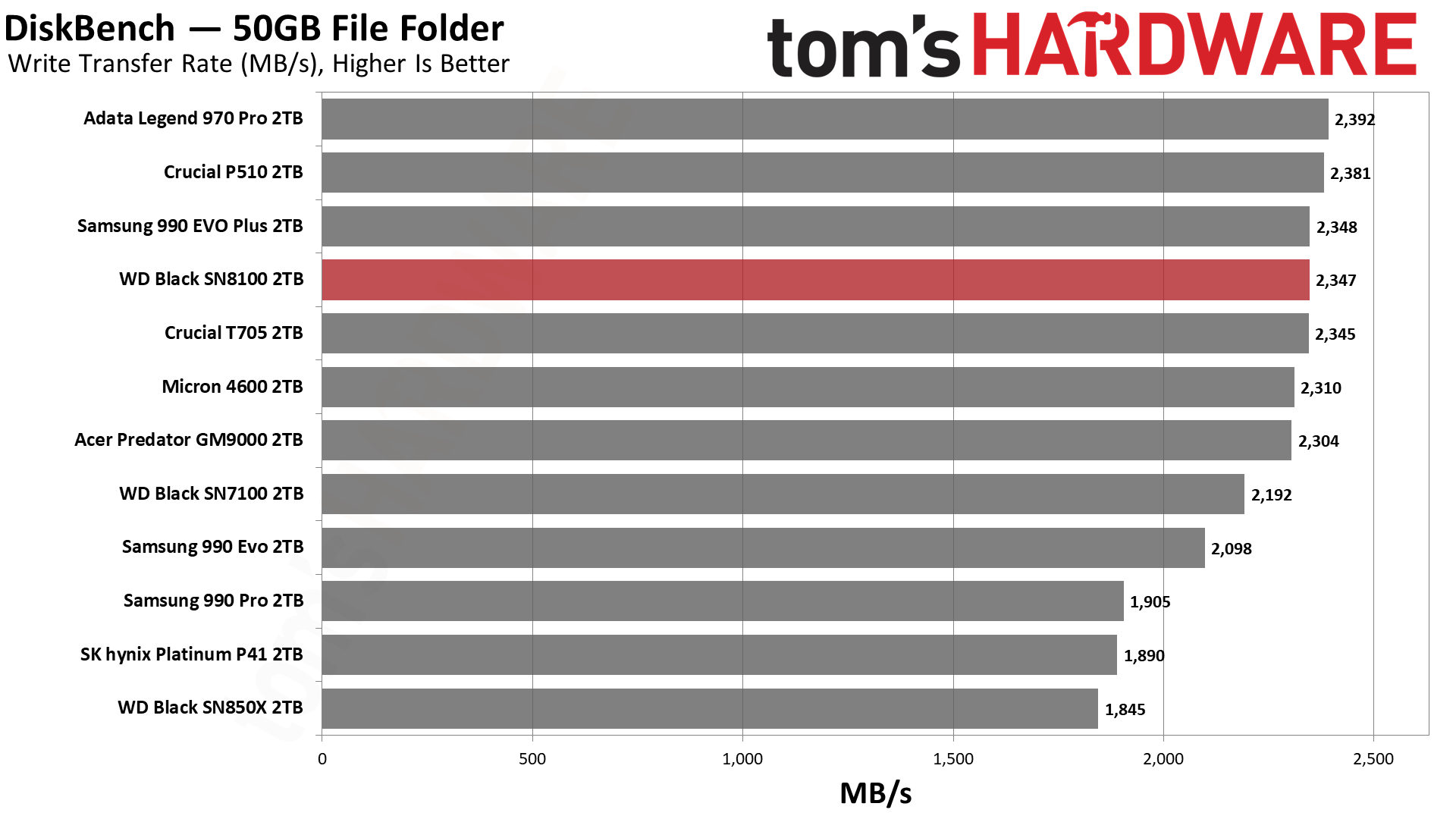
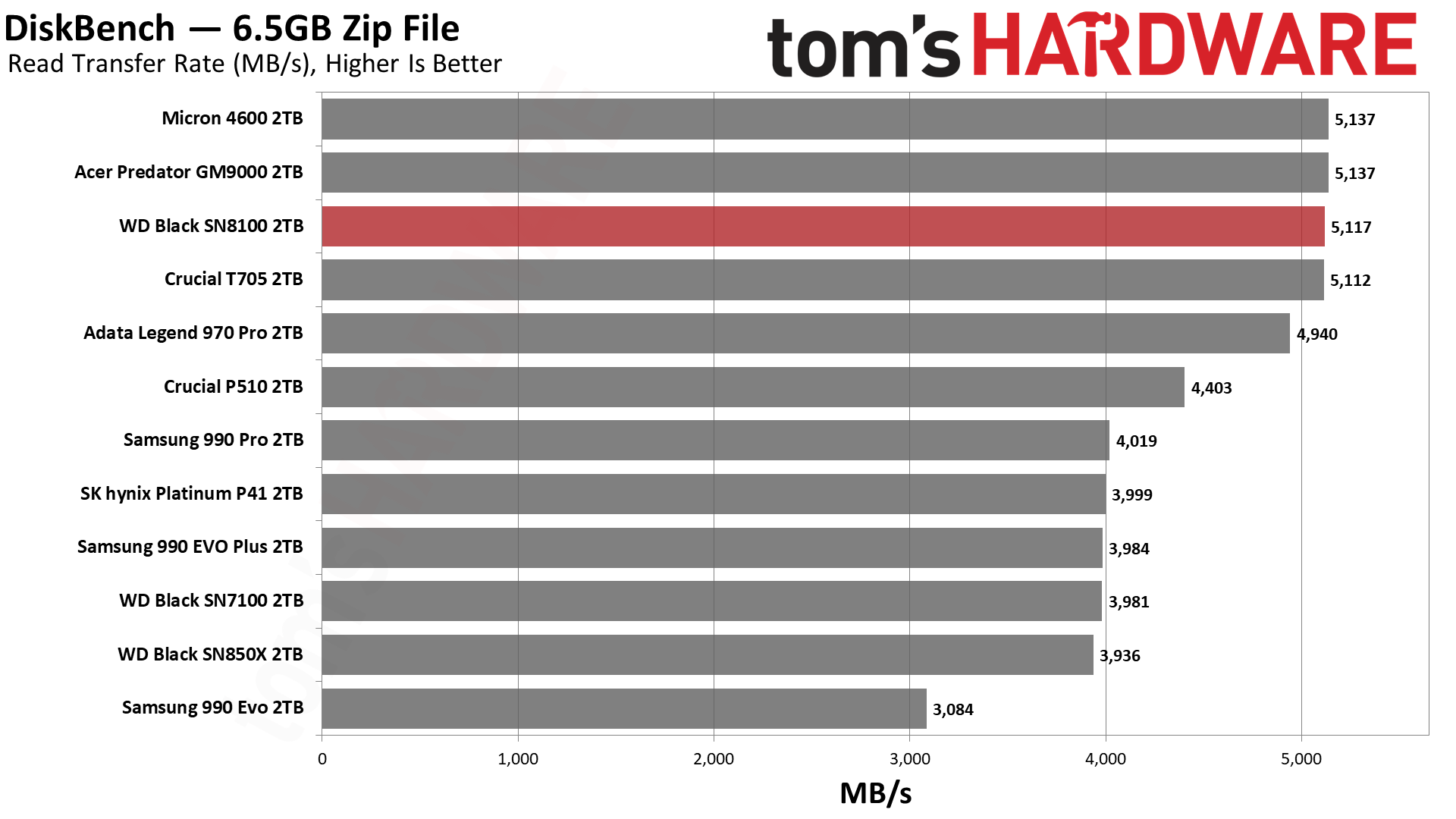
There are still limits for the interface, though. The WD Black SN8100 does its best to muster more performance, but it’s essentially at the max, which was reached by the T705 quite a while ago.
Synthetic Testing — ATTO / CrystalDiskMark
ATTO and CrystalDiskMark (CDM) are free and easy-to-use storage benchmarking tools that SSD vendors commonly use to assign performance specifications to their products. Both of these tools give us insight into how each device handles different file sizes and at different queue depths for both sequential and random workloads.
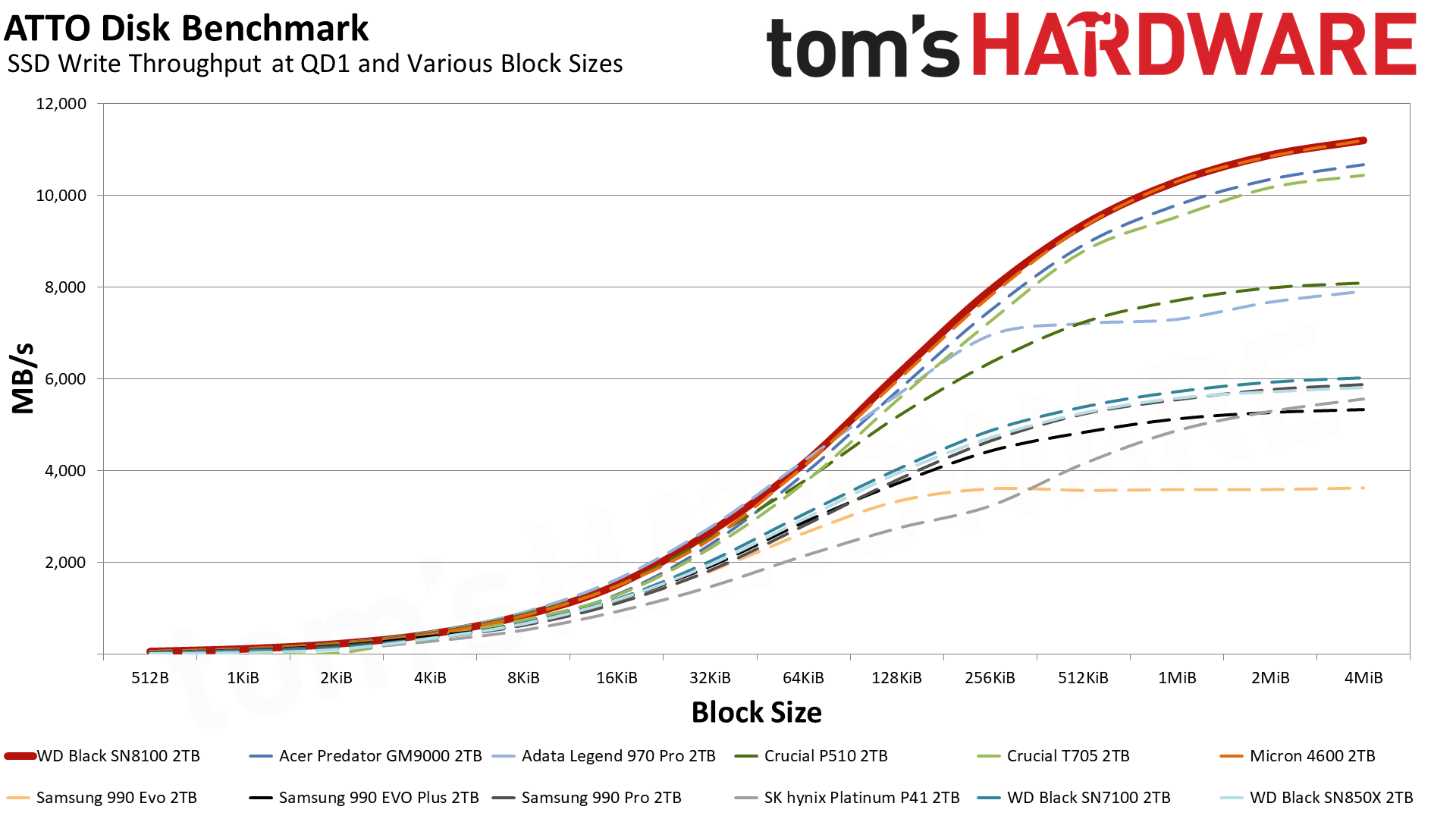
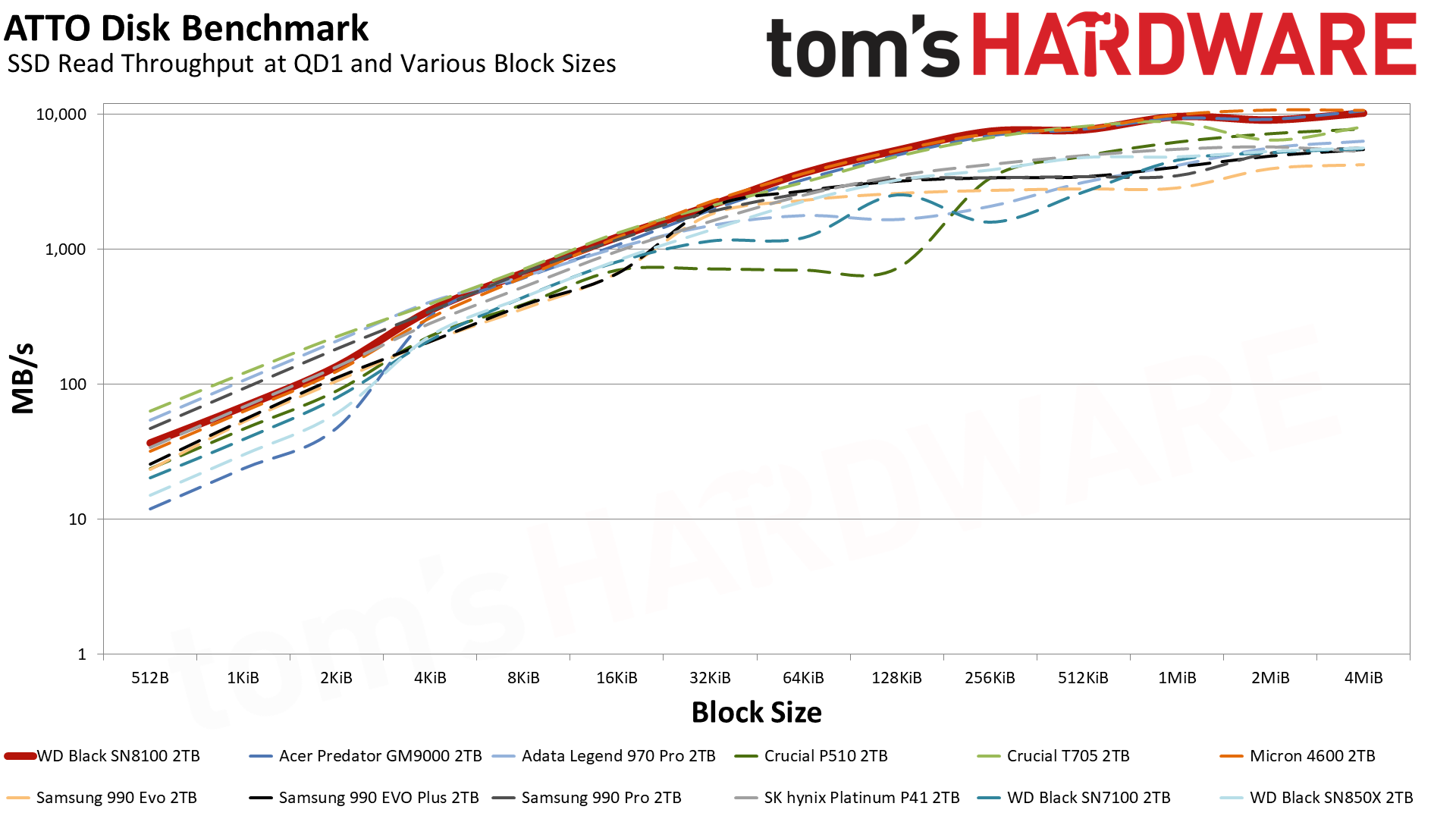
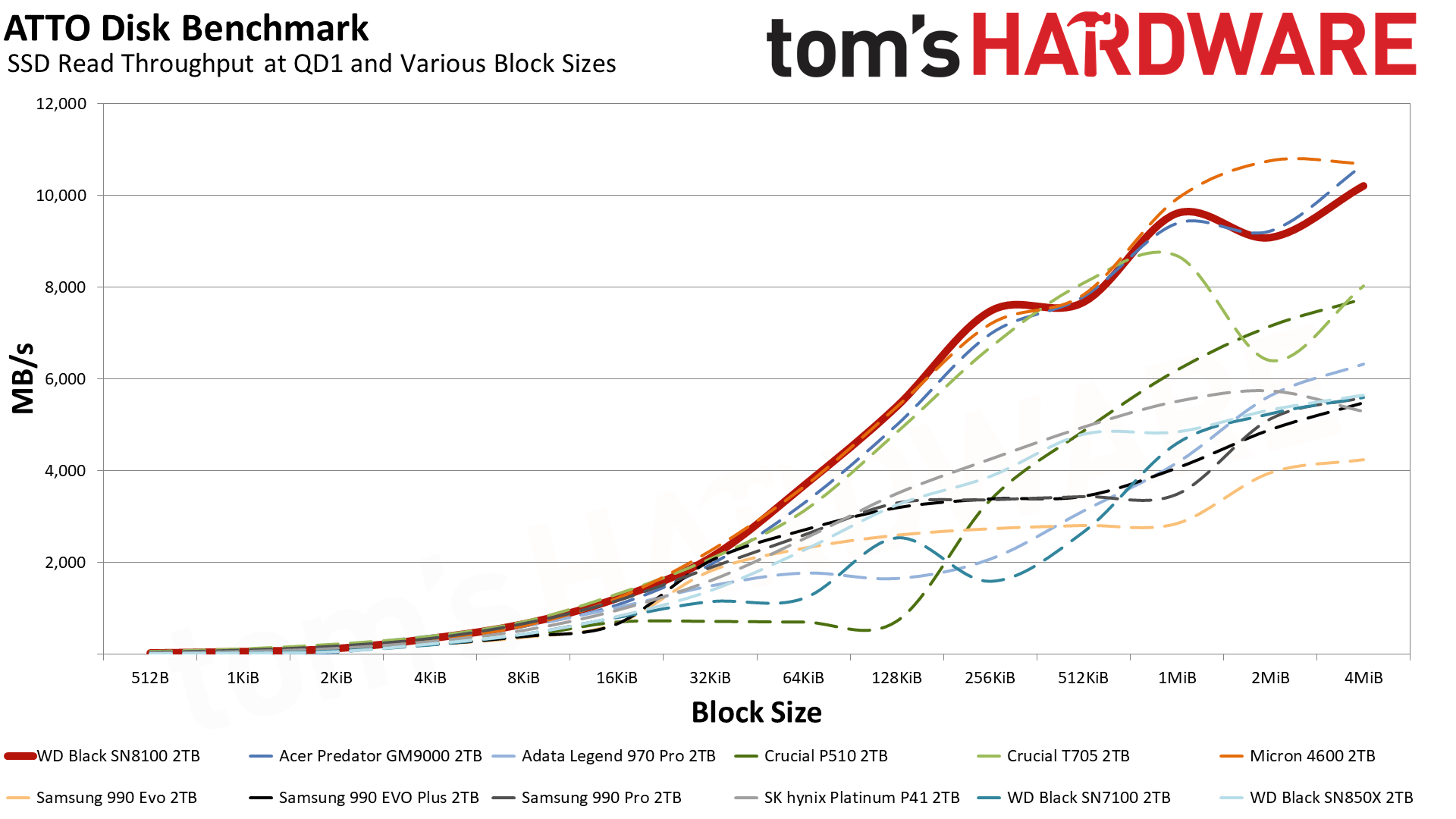
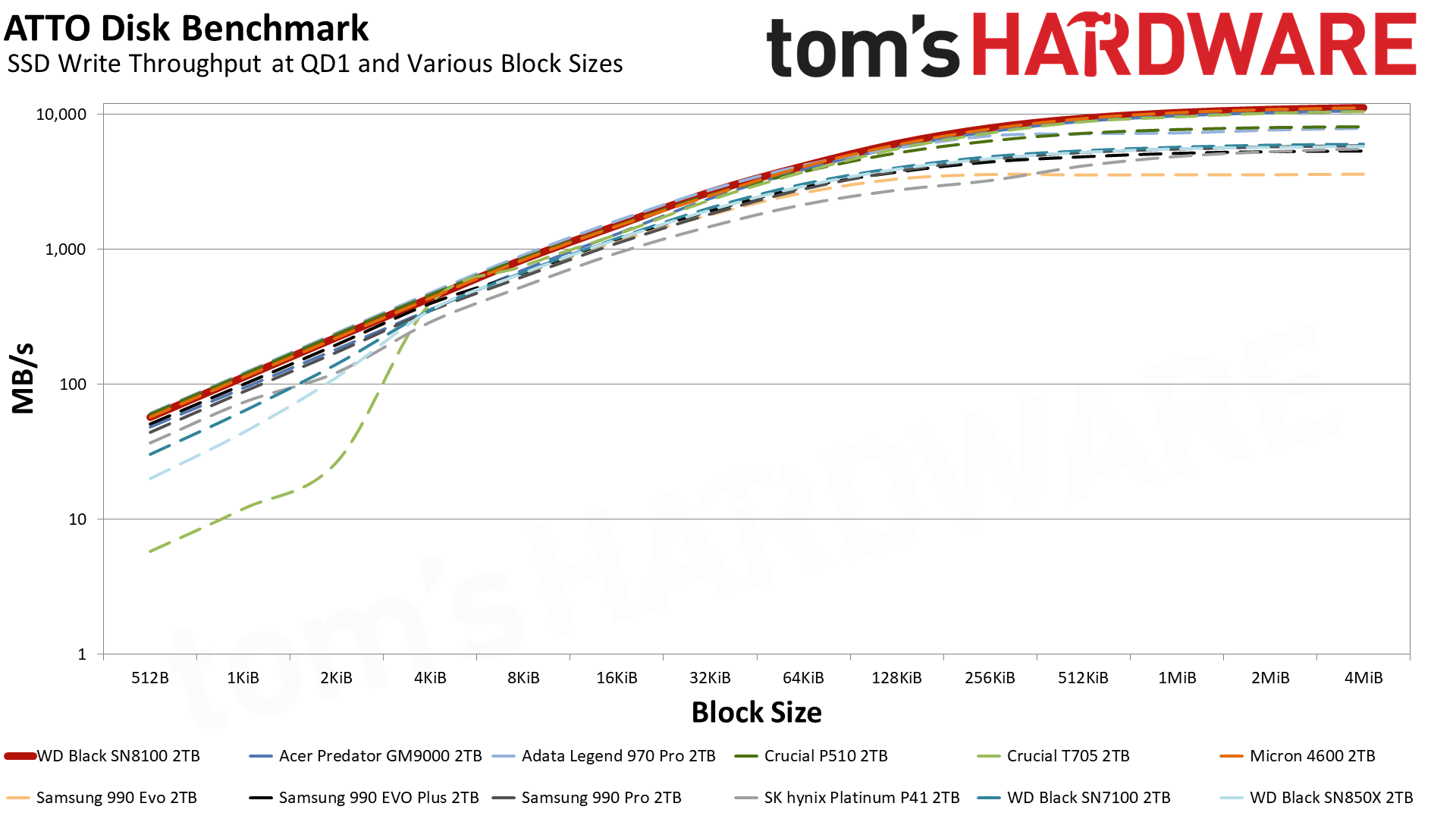

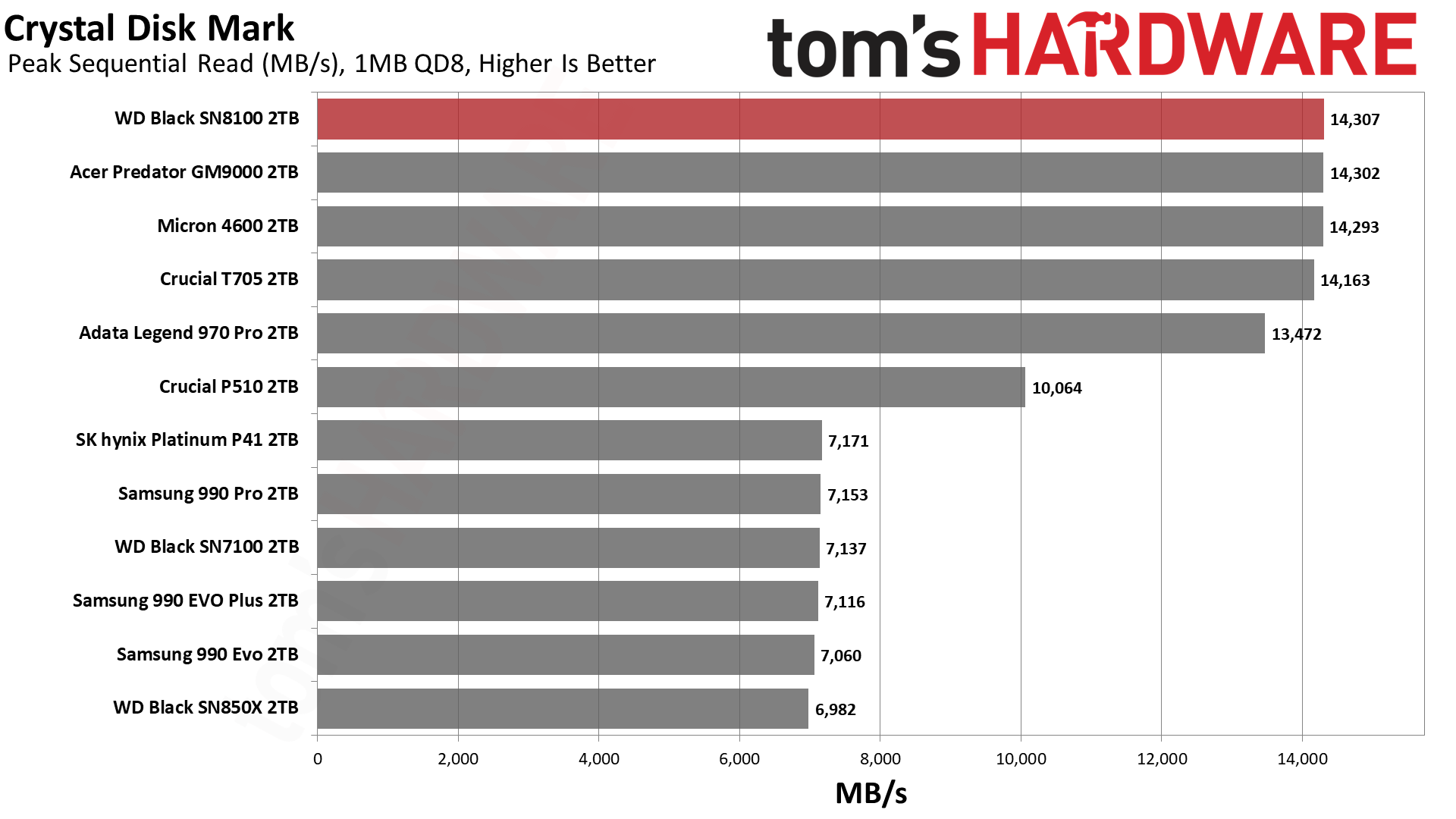
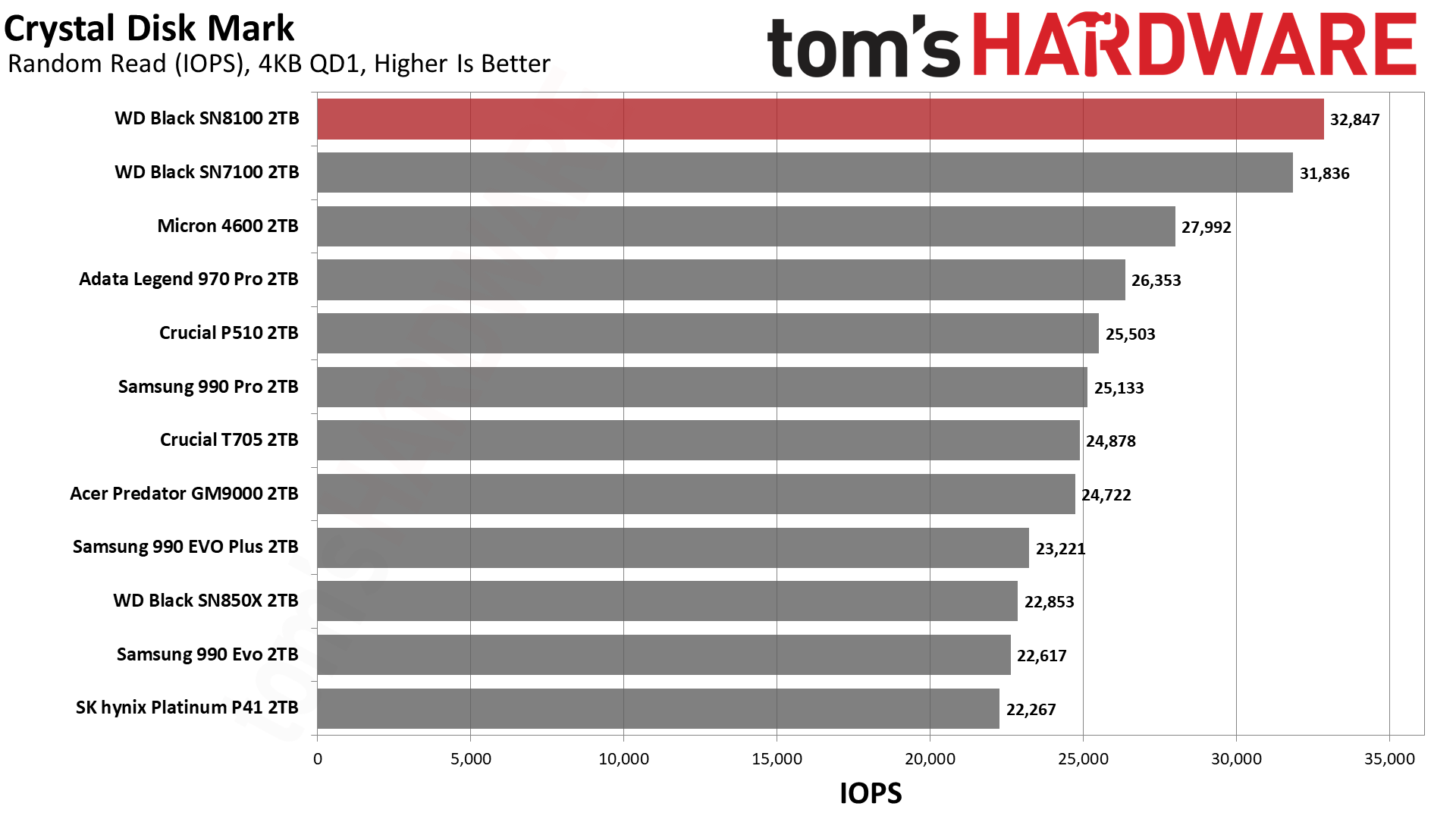
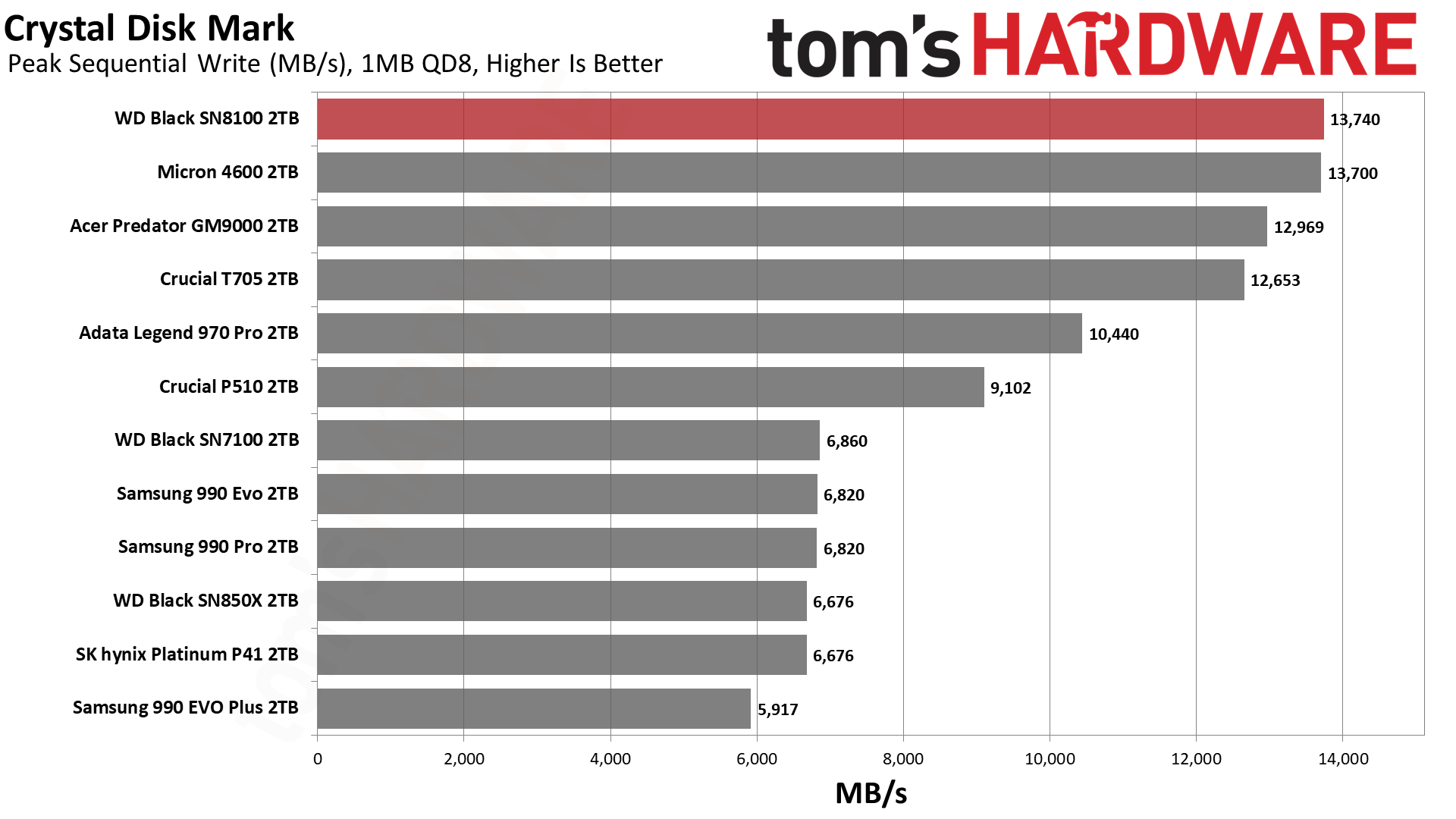
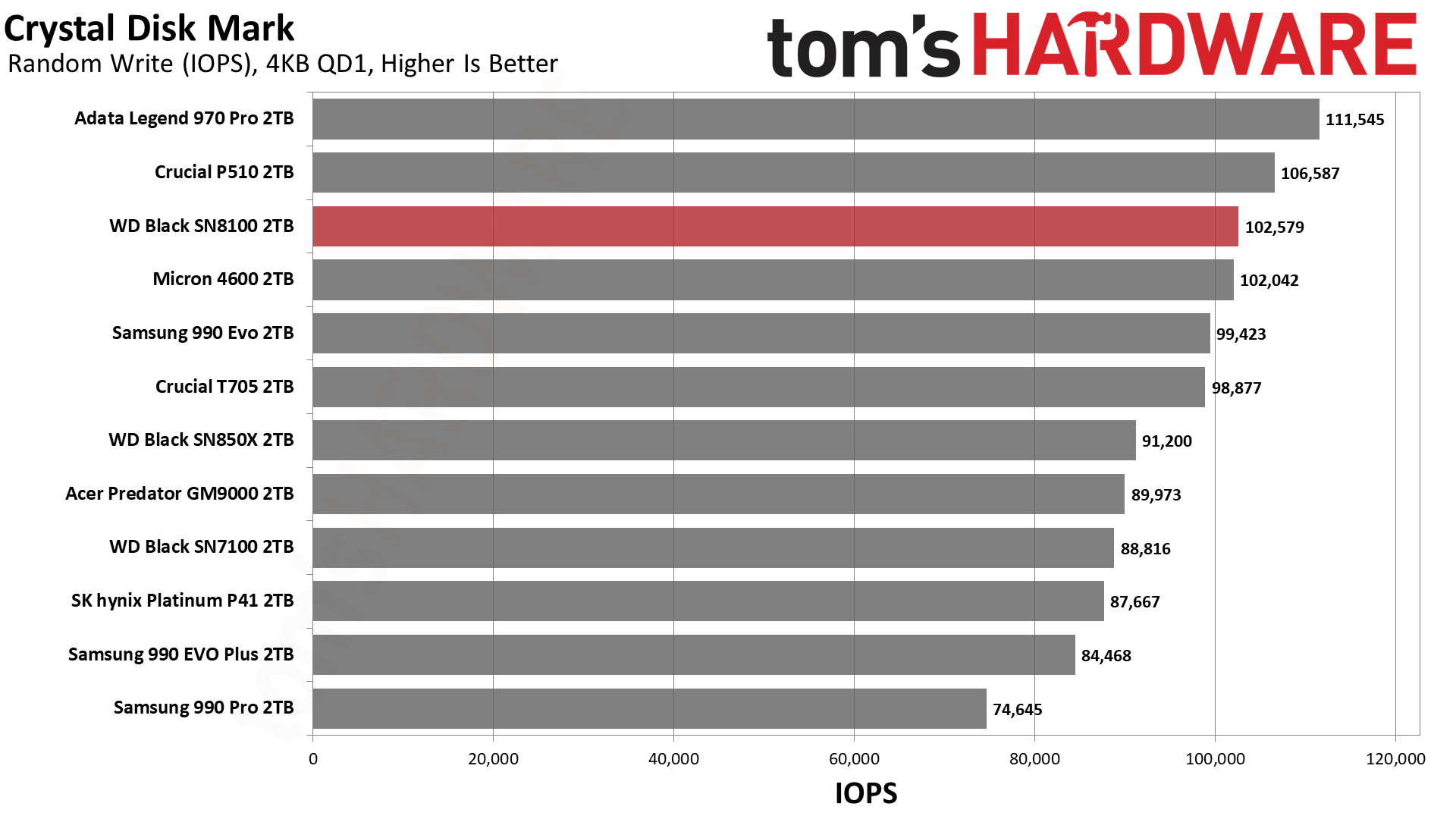
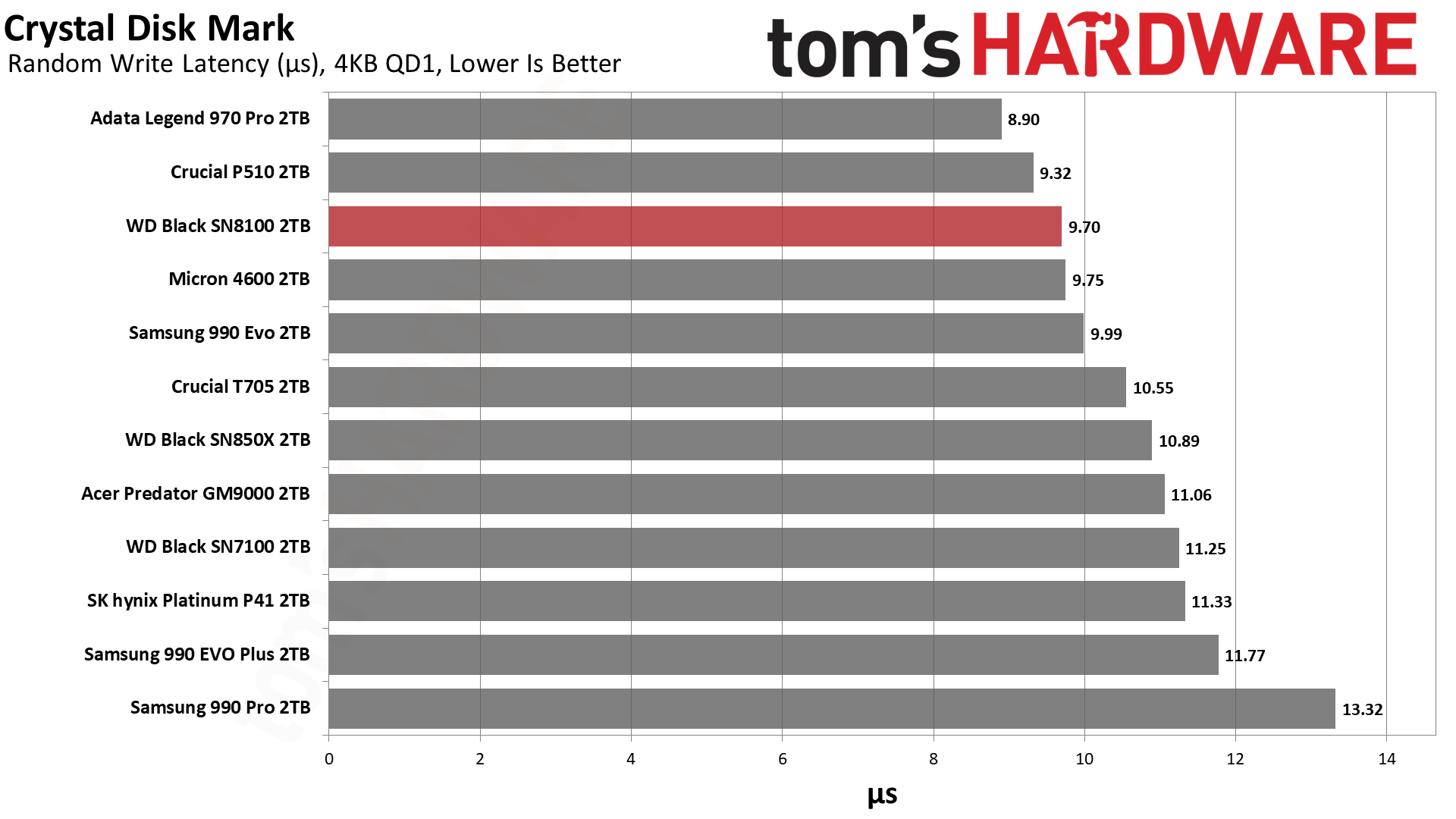
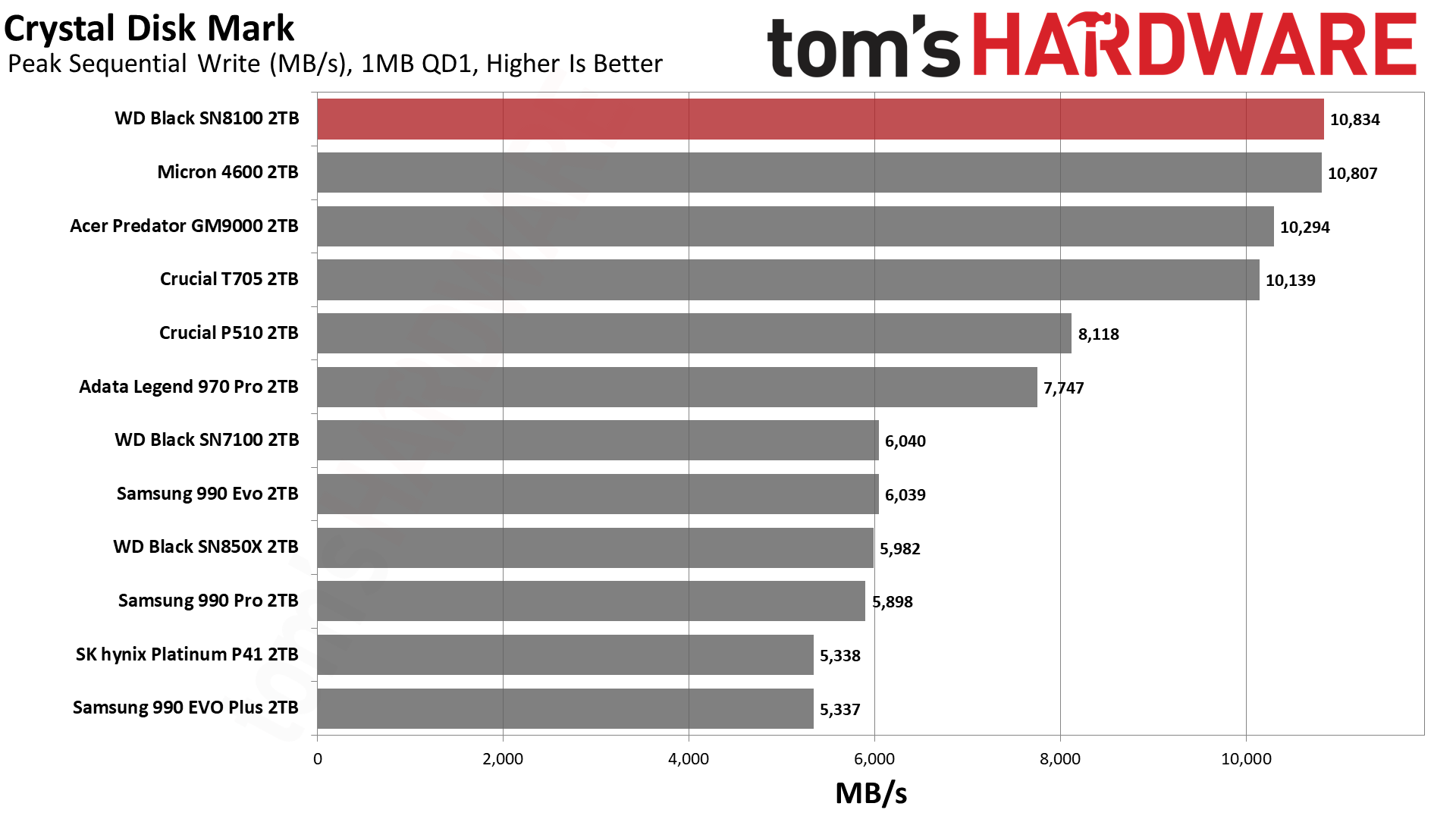
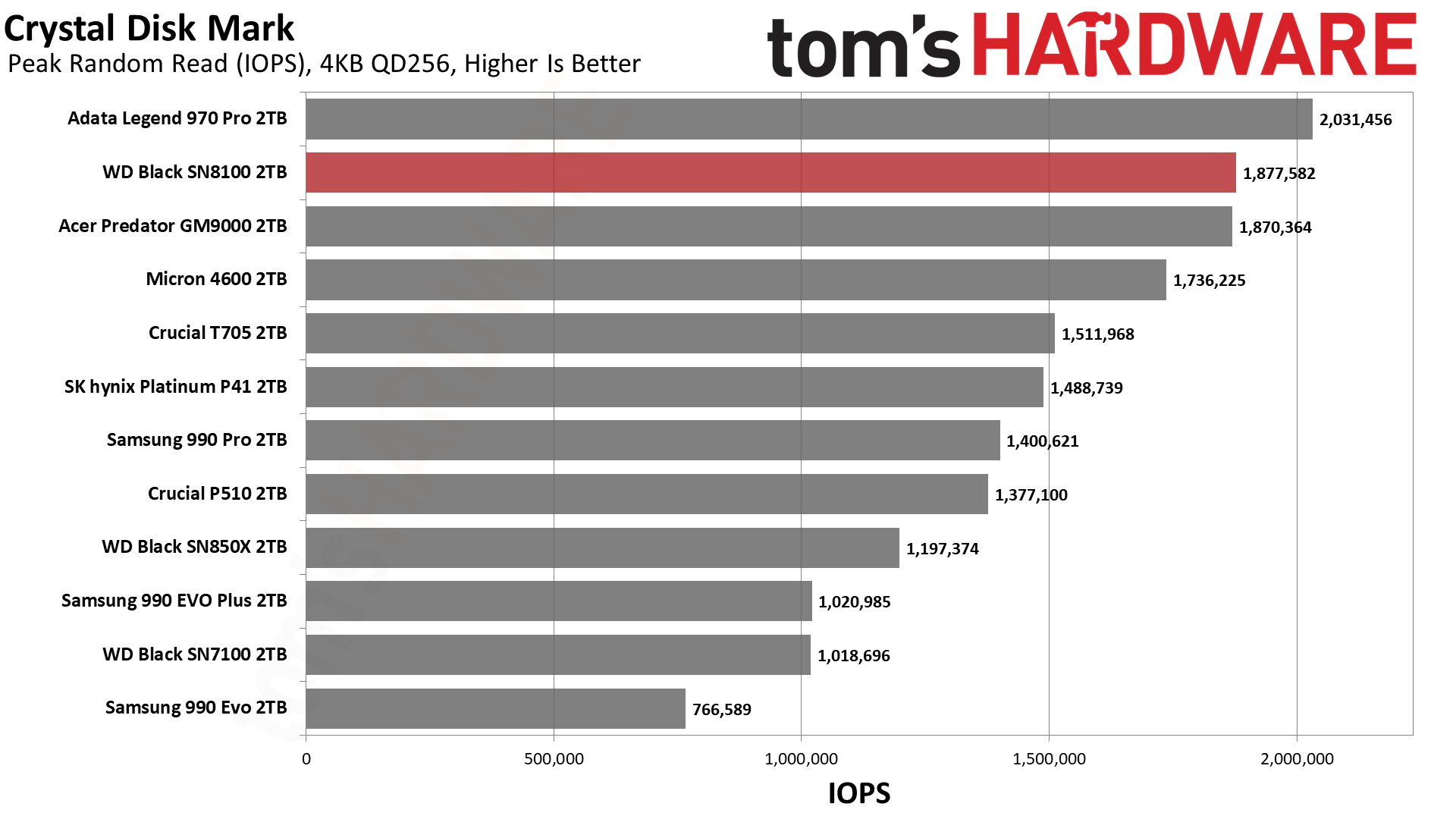

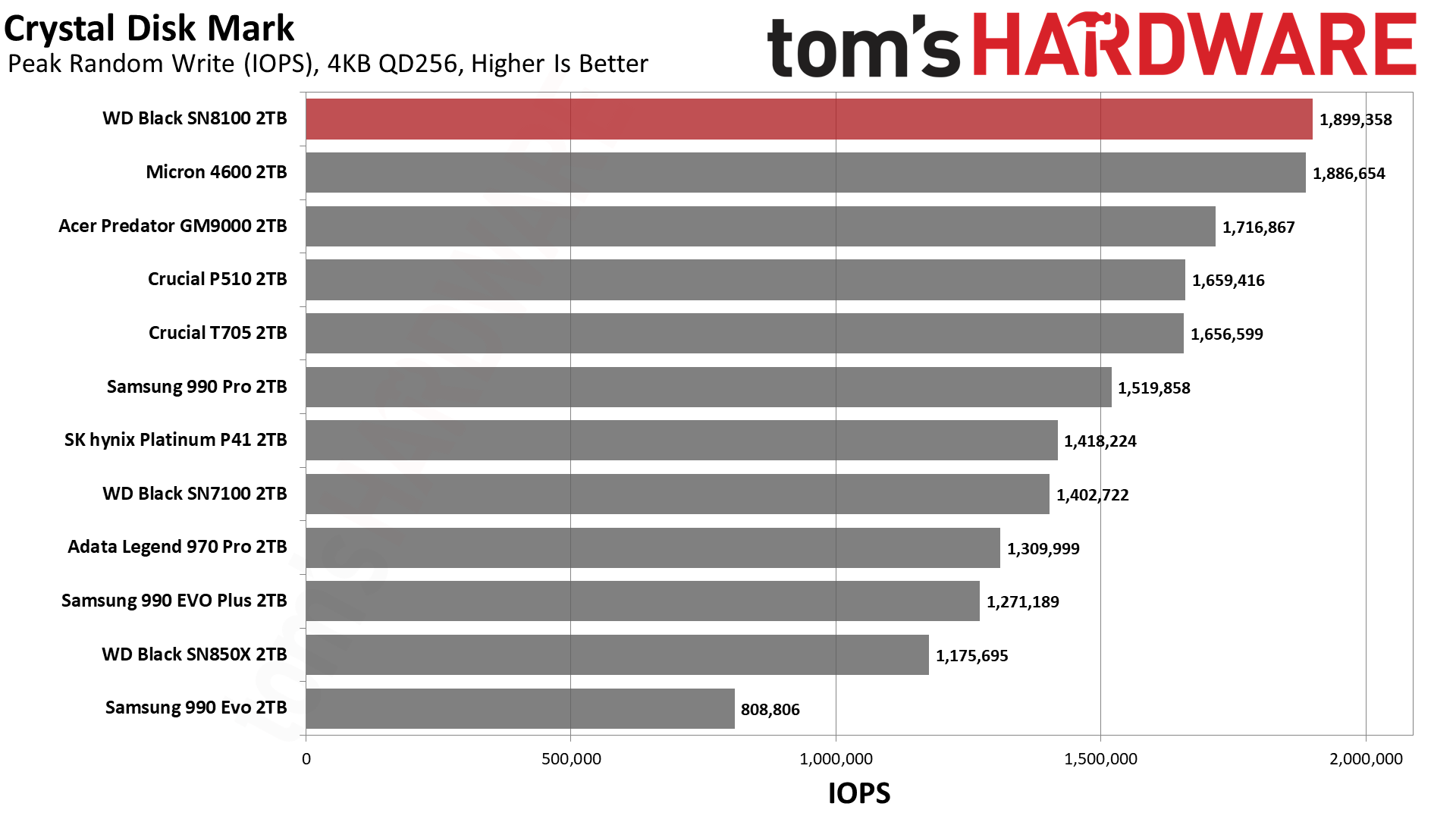
Performance in ATTO is exceptional, and CrystalDiskMark doesn’t disappoint, either. A drive like this is usually purchased for its throughput, but as with the Black SN710,0 the random read performance is exemplary. It’s still NAND flash technology, and that has its limitations, but the WD Black SN8100 basically takes it to its limits. Quite simply, it’s the fastest overall consumer SSD ever made.
Sustained Write Performance and Cache Recovery
Official write specifications are only part of the performance picture. Most SSDs implement a write cache, which is a fast area of pseudo-SLC (single-bit) programmed flash that absorbs incoming data. Sustained write speeds can suffer tremendously once the workload spills outside of the cache and into the "native" TLC (three-bit) or QLC (four-bit) flash. Performance can suffer even more if the drive is forced to fold, which is the process of migrating data out of the cache in order to free up space for further incoming data.
We use Iometer to hammer the SSD with sequential writes for 15 minutes to measure both the size of the write cache and performance after the cache is saturated. We also monitor cache recovery via multiple idle rounds. This process shows the performance of the drive in various states as well as the steady-state write performance.
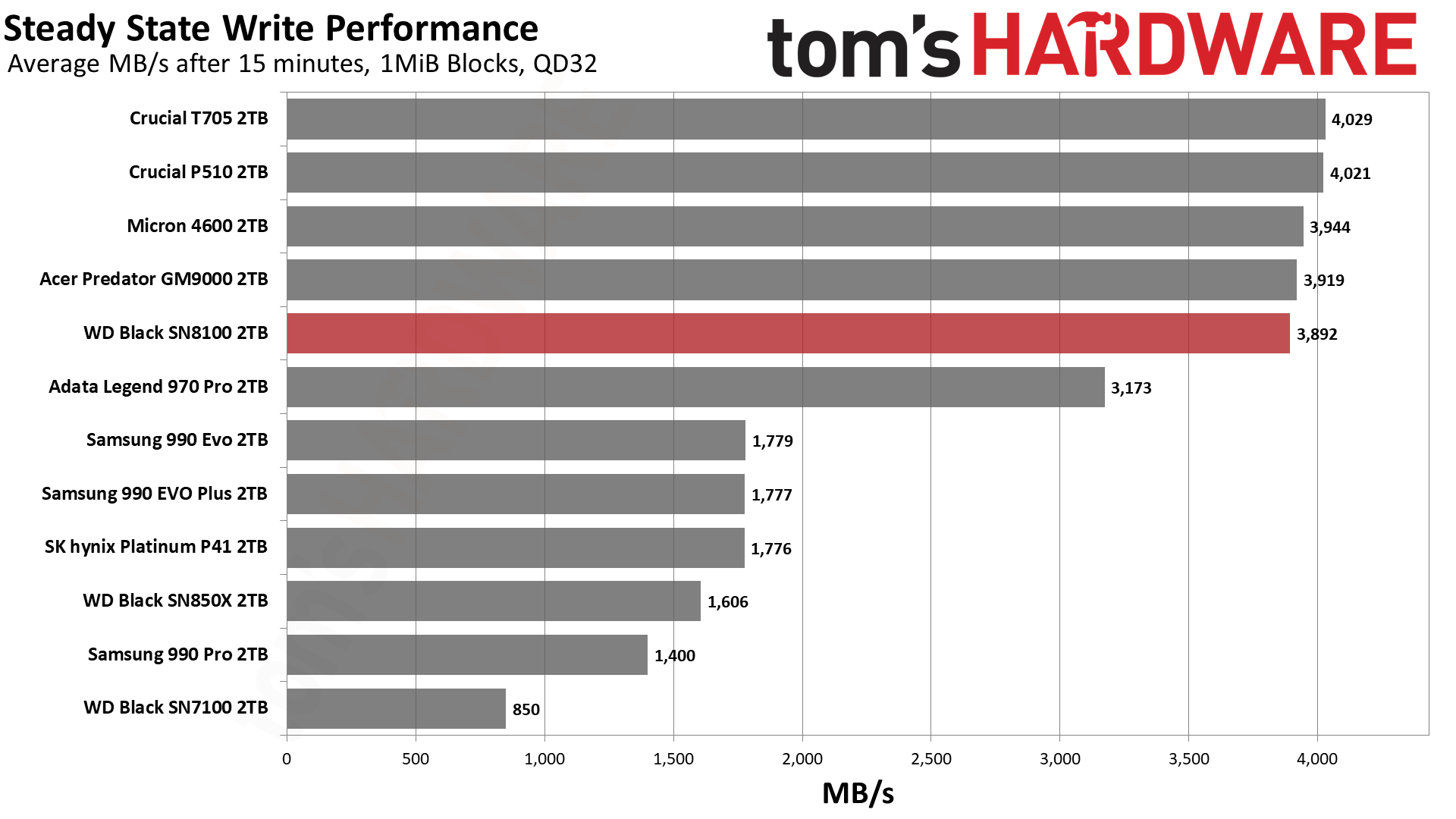
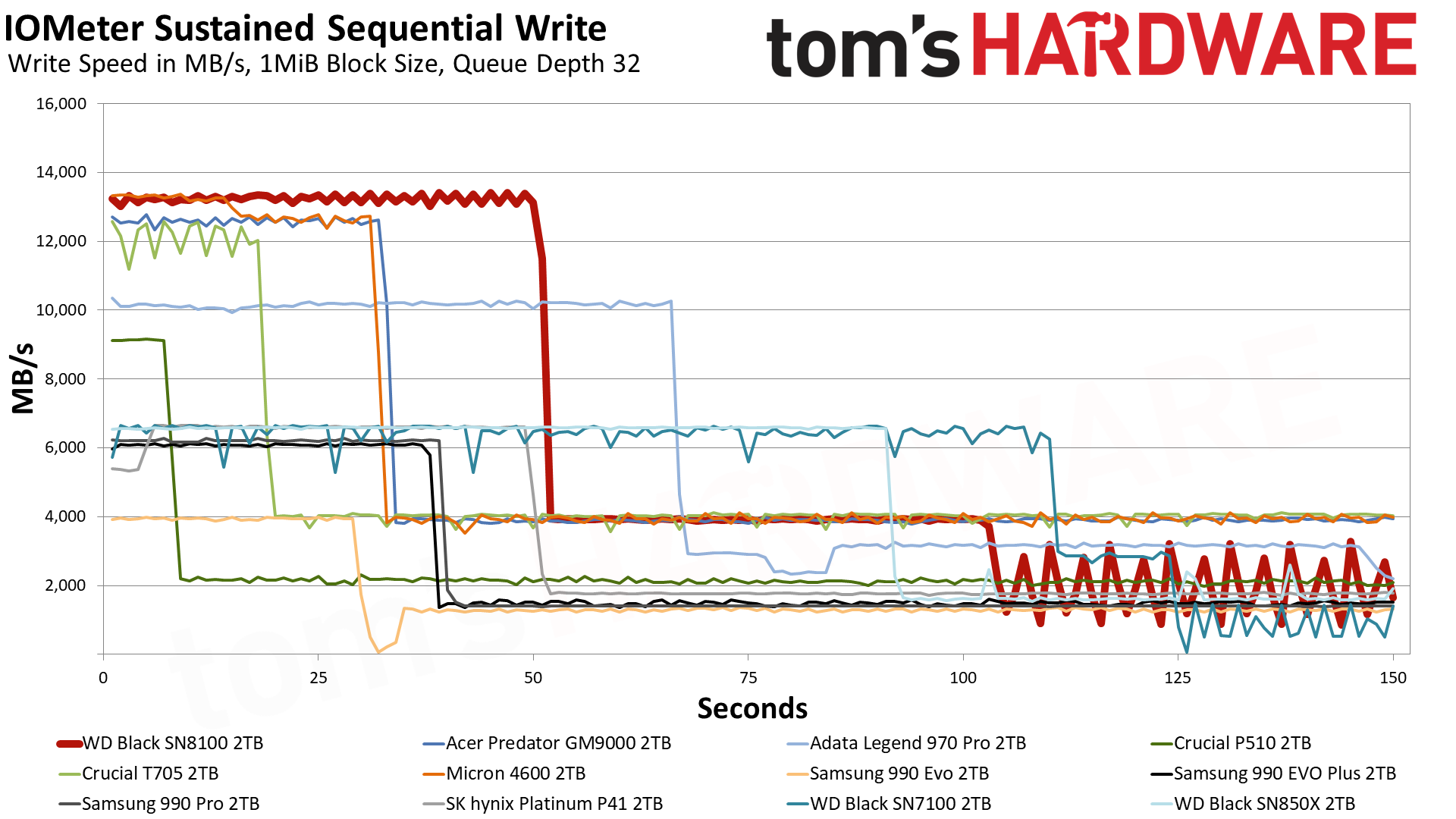

The 2TB WD Black SN8100 at first writes in the fast, single-bit pSLC mode at over 13.2 GB/s. It does this for quite some time, making its ability to cache writes unparalleled, beating even the 4600. The cache is almost the maximum size possible – about 1/3rd the total capacity – which lines up with previous WD and Sandisk drives using the newest caching scheme.
WD has optimized this to generally avoid super-slow speeds outside of the cache and, indeed, the TLC mode at 3.9 GB/s is almost as fast as the 4600’s and can come close to the T705. The drive does eventually end up in a less consistent, slower folding mode where it’s trying to reclaim space from the cache, but this is only after a lot of writes. This drive should be useful in a wide range of applications – Sandisk even touts AI – without any real drawbacks when it comes to writes or drive utilization.
Power Consumption and Temperature
We use the Quarch HD Programmable Power Module to gain a deeper understanding of power characteristics. Idle power consumption is an important aspect to consider, especially if you're looking for a laptop upgrade as even the best ultrabooks can have mediocre stock storage. Desktops may be more performance-oriented with less support for power-saving features, so we show the worst-case.
Some SSDs can consume watts of power at idle while better-suited ones sip just milliwatts. Average workload power consumption and max consumption are two other aspects of power consumption but performance-per-watt, or efficiency, is more important. A drive might consume more power during any given workload, but accomplishing a task faster allows the drive to drop into an idle state more quickly, ultimately saving energy.
For temperature recording we currently poll the drive’s primary composite sensor during testing with a ~22°C ambient. Our testing is rigorous enough to heat the drive to a realistic ceiling temperature.
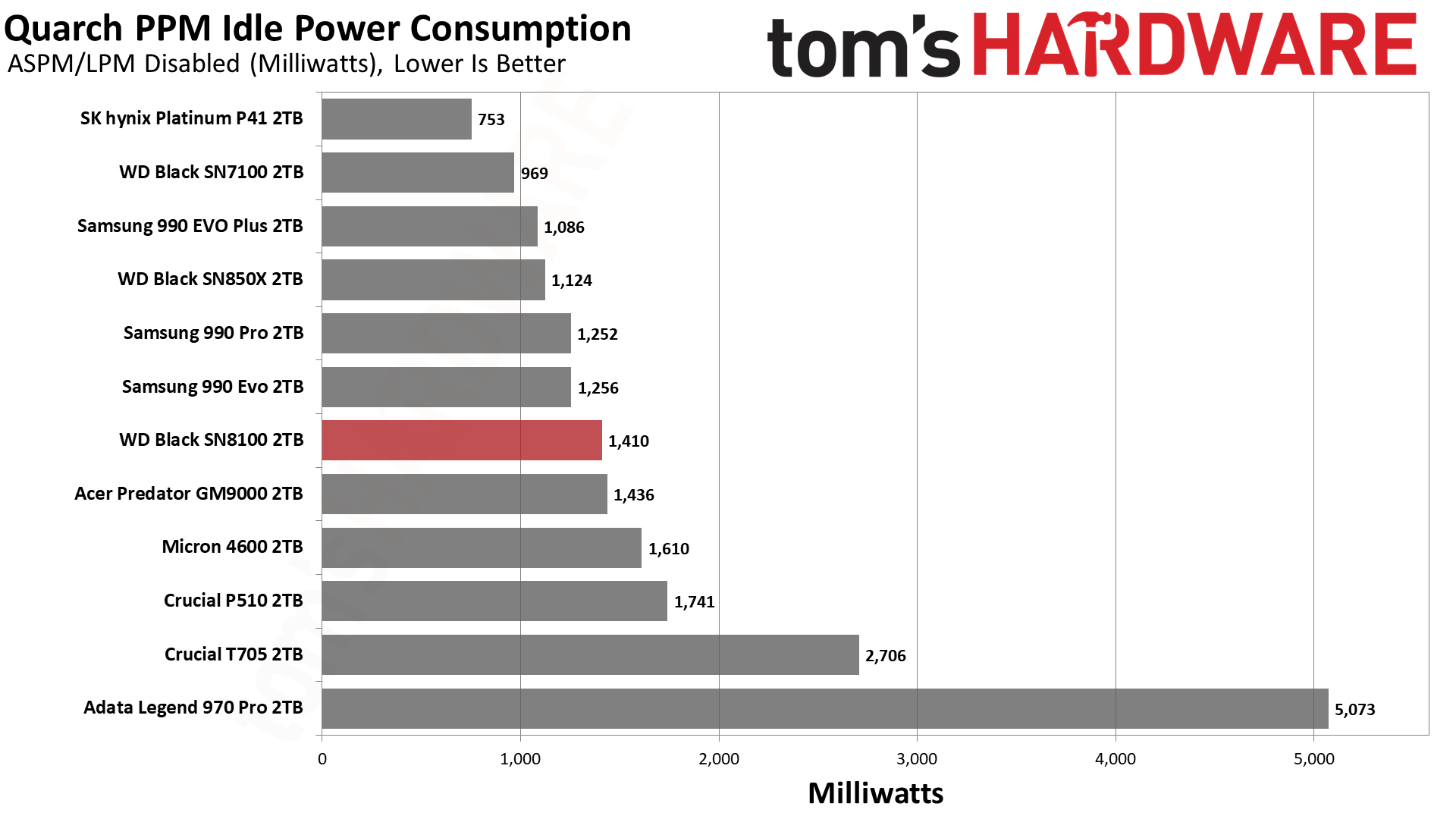
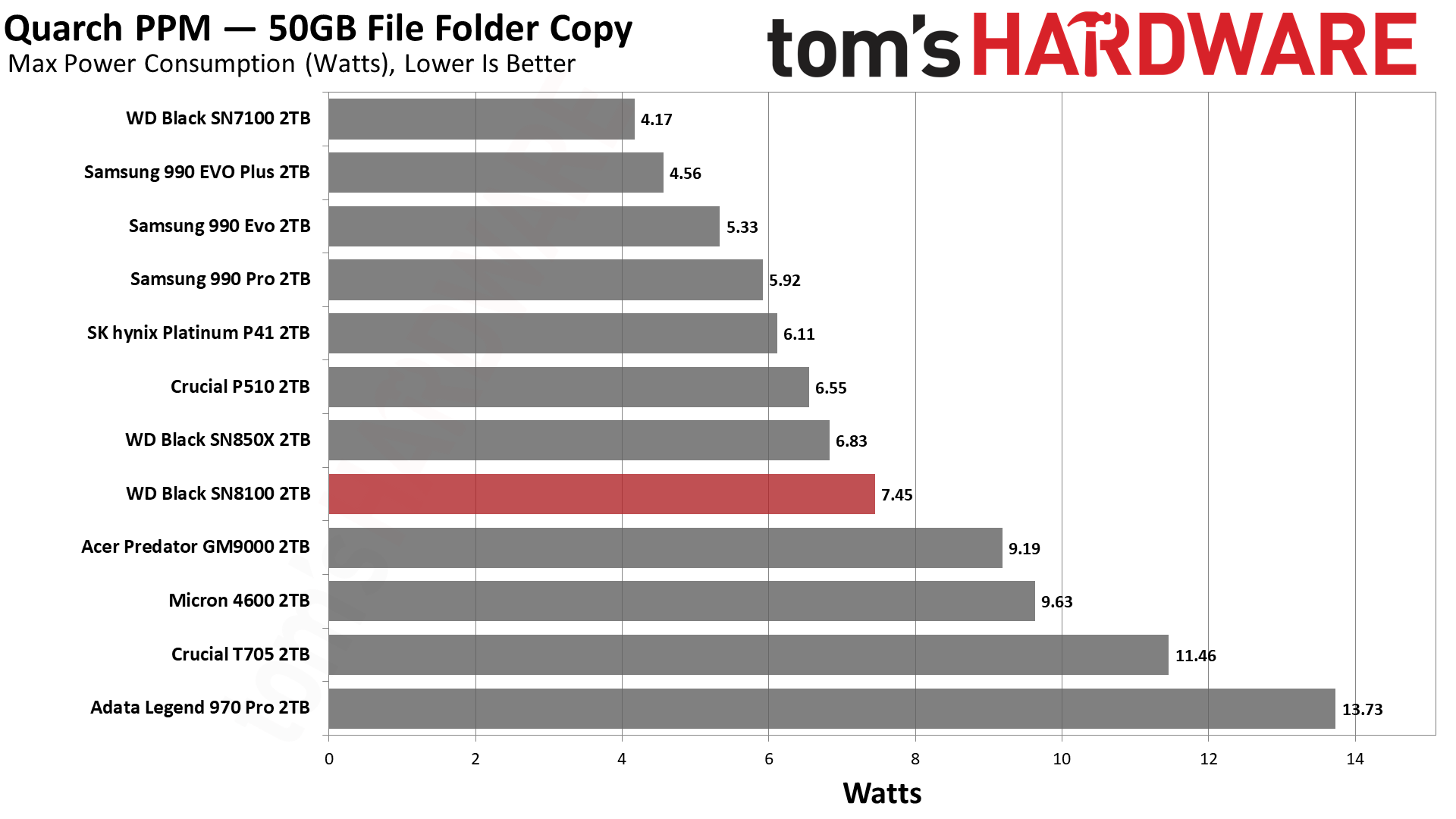
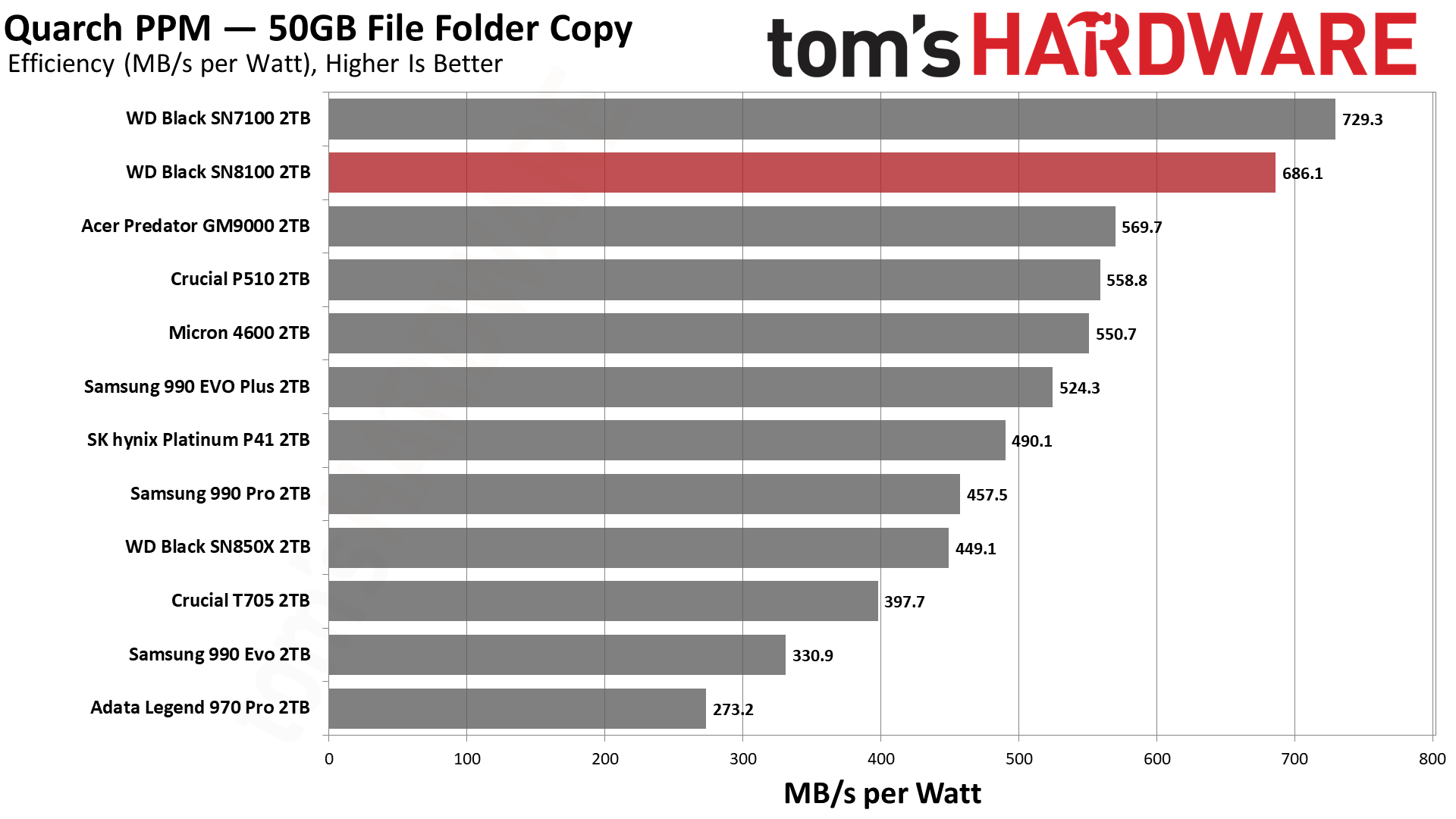
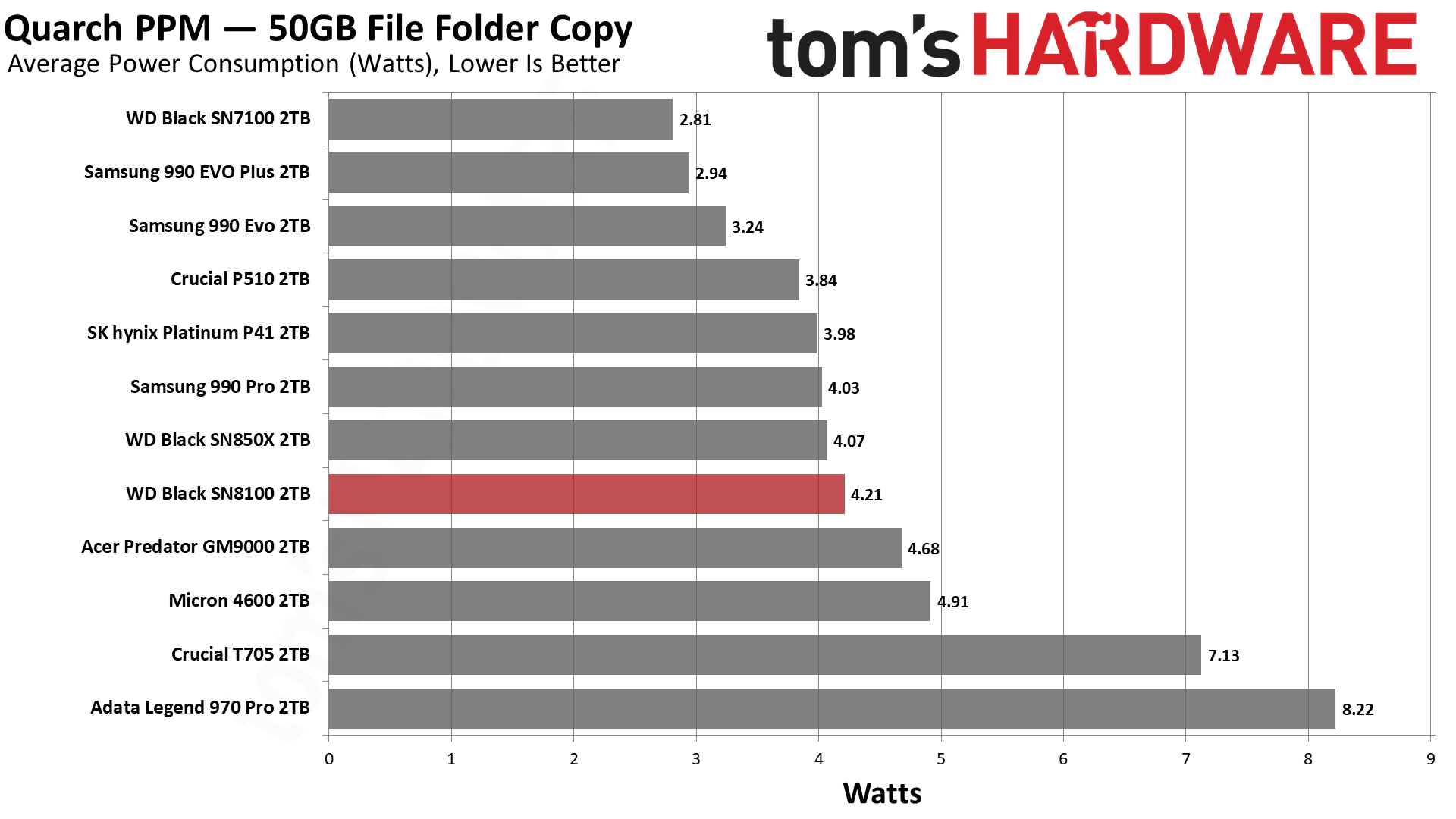
The WD Black SN8100 is exceptionally power-efficient, following up the Black SN7100 in topping the charts for each respective class of drive. There is nothing even close to this level of power efficiency and performance combined in one package.
It should be even more efficient in a PCIe 4.0 slot, so using it in a laptop – if you are willing to spend to get the very best – even with a last-gen M.2 interface is quite all right. This is not a drive that will overheat even without a heatsink, although we recommend using one if you plan to use it in a desktop.
Test Bench and Testing Notes
CPU | Row 0 - Cell 2 | |
Motherboard | Row 1 - Cell 2 | |
Memory | Row 2 - Cell 2 | |
Graphics | Intel Iris Xe UHD Graphics 770 | Row 3 - Cell 2 |
CPU Cooling | Row 4 - Cell 2 | |
Case | Row 5 - Cell 2 | |
Power Supply | Row 6 - Cell 2 | |
OS Storage | Row 7 - Cell 2 | |
Operating System | Row 8 - Cell 2 |
We use an Alder Lake platform with most background applications such as indexing, Windows updates, and anti-virus disabled in the OS to reduce run-to-run variability. Each SSD is prefilled to 50% capacity and tested as a secondary device. Unless noted, we use active cooling for all SSDs.
Sandisk WD Black SN8100 Bottom Line
The Sandisk WD Black SN8100 is simply the pinnacle of high-performance SSD design. It delivers excellent performance across the board and does it while being more efficient than even the most efficient last-generation drives. It does not have to sacrifice in any way to achieve this, making it an excellent pick for just about anything and anyone. If you’ve been waiting to pick up a PCIe 5.0 SSD because earlier ones seemed lacking in one way or another, the time has come. It would be difficult to recommend any other drive if you’re looking for the best-performing drive without compromise.
A perfect drive deserves a perfect score, but this is a very high bar to reach for us. The WD Black SN8100 is probably the SSD closest to reaching perfection in recent memory. However, we do have some minor criticisms. The drive’s pricing isn’t unfair, but Crucial has already put the T705 in a place where it might be more cost-effective for bandwidth-heavy scenarios. It’s also significantly more expensive than many drives that will give a similar experience in everyday usage. We’d also like to see something other than DDR4 for the volatile memory, although given the drive’s efficiency, this is very much a nitpick.
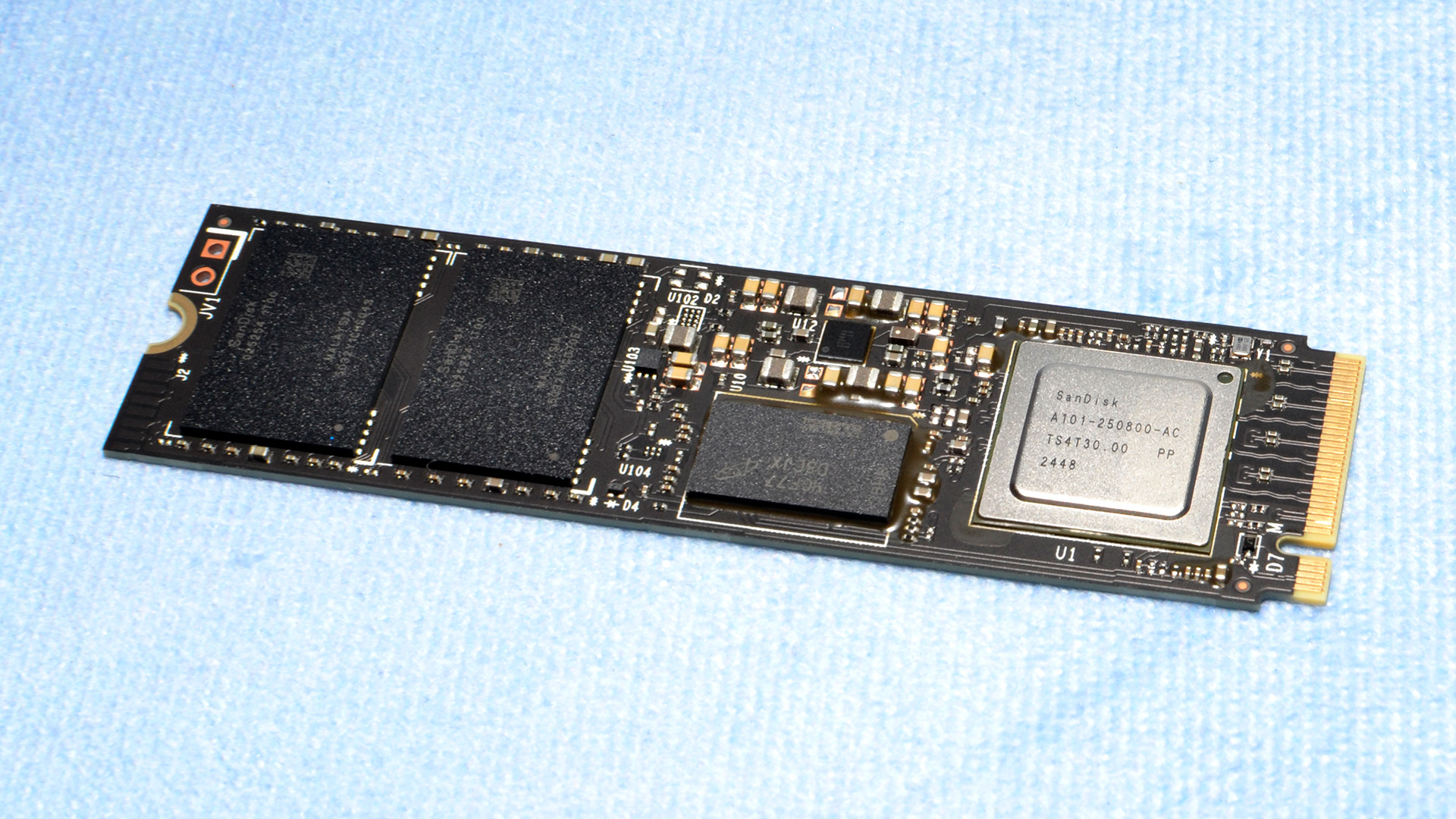
Other potentially problematic areas include the capacity range and warranty. Many people all but expect an 8TB model at this point, but Sandisk has to promise that down the road, and the current flash being used isn’t ideal for that capacity. We do think it’s a plus that Sandisk mentioned the 8TB SKU out of the gate at least.
The warranty also only covers 600TB of writes per TB capacity, which is very much standard, but not something that screams that it’s a premium drive. An expensive workhorse drive should have a higher range, even if 99% of users never reach it. Some minor adjustments would make the drive’s price easier to handle, but ultimately, we think the price will be competitive, which means that by the time we review the 8TB model, this might very well be a 5/5 drive.
The WD Black SN8100 isn’t for everyone, though. Unless you are really pushing for maximum performance or want a system with multiple high-bandwidth drives for transfers and content creation, it’s generally more than you need. It is efficient enough that it’ll work in a wide range of systems, unlike, say, the T705, which can make it a great choice if your budget isn’t a top priority. We’d have difficulty recommending any other drive if your heart is set on a PCIe 5.0 SSD.
If you don’t need full 5.0 performance and just want a fast, efficient drive, something built on Phison’s E31T, like the PNY CS2150, could make more sense. Dropping down to 4.0 there are myriad drives to choose from, including Sandisk’s own excellent Black SN7100. In many cases, a drive – or one like it, such as the Samsung 990 EVO Plus, might be a better option than “budget” 5.0 drives like the CS2150.
It’s a steep step to climb from those to the WD Black SN8100, which means the drive will be out of reach for many, but it should be included in any PC build or upgrade list that wants true cutting-edge performance. There’s simply no better option.
MORE: Best SSDs
MORE: Best External SSDs
- 1
- 2
Current page: Sandisk WD Black SN8100 2TB Performance Results
Prev Page Sandisk WD Black SN8100 Introduction
Shane Downing is a Freelance Reviewer for Tom’s Hardware US, covering consumer storage hardware.
-
cyrusfox Chart topping performance, perhaps the premium price is warranted, still 2x more than I would want to pay for storage (even fastest on the market NAND which this appears to be). I love WD, They have done well with the sandisk line, they make the best small form factor drives (22x30). And it looks like they have tamed gen 5 and are showing a performance and latency lead nearly everywhere. But on the real world task, they are all overkill, so I don't see myself paying extra per TB just for the milli-seconds of gains on display.Reply
Times like these make me wish Optane could have survived a couple years longer to truly push the boundaries on each new connection standard. Although I am bet the power consumption of such a device would rival that of a sff GPU. -
dwd999 Hoping for a future 3-way shootout between WD SN8100, Samsung 9100 Pro, and newly announced Crucial T710. Hopefully each with their own heatsinks. Please! (Would be nice to buy on Labor Days sale).Reply -
Loadedaxe Why are you using a Hynix P41 in this .... ?Reply
The P51 is the Gen 5 model from SK Hynix, not the 41, that's Gen 4 -
Albert.Thomas I wish this had included some comparisons with Intel Optane drives, but nonetheless - this product looks GOOD!Reply -
Makaveli This drive looks great and will most likely be a replacement for my current OS drive WD SN850X 2TB. No rush though will wait to see what prices of this drive will be like in the fall.Reply -
SimonNVC Would the Samsung 9100 Pro not have made a better choice for comparison than the Gen 4 Samsung drives included in the results?Reply -
mac_angel Your title says 2TB, but your links are for the 1TB models.Reply
As for Sandisk's history, I give it 6 months, tops, before they start swapping out the various chips on the m.2 drive. -
Makaveli Reply
This is my only concern with SD. That is something western digital never did.mac_angel said:As for Sandisk's history, I give it 6 months, tops, before they start swapping out the various chips on the m.2 drive.
So I may have to grab one in the first 3 months. -
DavidLejdar That is what I kept a M.2 slot free for. But, here in Europe, unemployed for a few weeks now, as U.S. corporate profits of more than $3,500 per U.S. inhabitant and per month (after tax), apparently isn't enough... And now I have less money to spend with U.S. companies - as that somehow is what the U.S. wants? Not sure I understood it all, including the part, why inclusion of civil war veterans and their widows, is now considered a bad thing? But anyhow, maybe some time in the future.Reply
